
Volume 45 No.1/2023 BUSH FIRE bulletin The journal of the FIRES AND FLOODS MEAN A BUSY SEASON • INTRODUCING NEW MOBILE DATA TERMINALS ACROSS THE STATE • CURED GRASSLANDS CREATE A PERFECT STORM FOR FIREFIGHTERS • FIRES NEAR ME BECOMES HAZARDS NEAR ME MENTAL HEALTH STRATEGY2023-2027
CANOBOLAS ZONE BANDS TOGETHER TO OVERCOME SEVERAL FIRES
In February 2023, Canobolas Zone crews fought three significant fires.
A GLIMMER OF HOPE AFTER THE FLOODS IN EUGOWRA
In November 2022, a severe flash flood impacted the small town of Eugowra in the Central West.
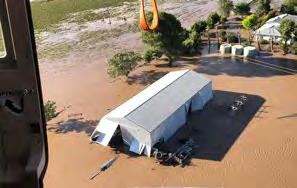
SUN COMES OUT FOR RFS
STATE CHAMPIONSHIPS
NSW’s finest firefighters were put to the test at the 25th RFS State Championships.
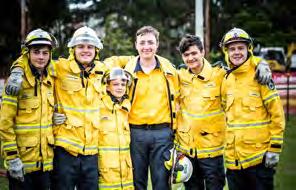
BUSH FIRE bulletin

Acknowledgement of Country
The NSW Rural Fire Service (RFS) acknowledges the Traditional Custodians of this country and their continued connection to land, sea and culture. We pay our respects to the resilience and strength of Elders past, present and emerging and extend that respect to all Aboriginal peoples.
Dissemination of content
The RFS encourages the availability, dissemination and exchange of public information. You may copy, distribute, display, download and otherwise freely deal with this material for personal, in-house or non-commercial use, on the condition that you include the copyright notice © State of New South Wales through the Rural Fire Service [plus year of creation or first publication] on all such uses.
In the event that you wish to copy, distribute, display, download, store, or use this material for a purpose other than personal, in-house or non-commercial use, you must obtain permission from the RFS by writing to the following address:
Commissioner
NSW Rural Fire Service
Locked Bag 17, Granville NSW 2142
You must also obtain permission from the RFS if you wish to:
• charge others for access to the work (other than at cost);
• include all or part of the work in advertising or a product for sale;
• modify the material; or
• use any trade mark from this publication, including the NSW Rural Fire Service crest.
Disclaimer Statement
While the material within this Bush Fire Bulletin is current at the time of writing changes in circumstances after the time of publication may impact on the accuracy of the material. Individuals are responsible for ensuring they have the most current version of this publication.
The information and material contained herein is general in nature and is intended for your use and information. The NSW Rural Fire Service (RFS) disclaims, to the extent permitted by law, all warranties, representations or endorsements, express or implied, with regard to the material contained herein. The RFS does not warrant or represent that the material contained herein is free from errors or omissions, or that it is exhaustive.
Users should exercise their own skill and care with respect to its uses. You must not assume that this material will be suitable for the particular purpose that you had in mind when using it.
The RFS disclaims any liability (including but not limited to liability by reason of negligence) to the users of the material for any loss, damage, cost or expense whether direct, indirect, consequential or special, incurred by, or arising by reason of, any person using or relying on the material and whether caused by reason of, any error, omission or misrepresentation in the material or otherwise.
Users of the website will be responsible for making their own assessment of the material and should verify all relevant representations, statements and information with their own professional advisers. All photos, unless otherwise stated, taken and owned by the NSW Rural Fire Service.
The views expressed in articles in the Bush Fire Bulletin do not necessarily reflect the views or the policies of the NSW Rural Fire Service.

CONTENTS FOREWORD 1 INCIDENTS Cured grasslands create a perfect storm for firefighters in Tambaroora 2 Four floods in four months 13 Bridge over troubled waters near Forbes 14 RFS members answer the calls to help out NSW SES 21 FEATURES RFS working with beekeepers to eradicate Varroa Mite 6 Fire trails: The first line of defence 8 RFS launches Mental Health Strategy for 2023-27 24 Indigenous art a proud feature of Bellbrook truck 30 IN FOCUS 10 GENERAL NEWS RFS-led initiative tackles arson attacks in Western Sydney Parklands 28 Fires Near Me becomes Hazards Near Me 29 Stars shine bright in Bungowannah 34 Any-weather friends: Goat pilots continue across NSW 35 New fire trail makes a great difference for Mount Helen community 38 Memorial garden dedicated to fallen firefighters unveiled in Dubbo 47 Celebrating 20 years of service from Assistant Commissioner Rebel Talbert 50 RESEARCH AND TECHNOLOGY Understanding Black Summer through research 12 Mobile Data Terminals: a new way of communicating 16 RFS to roll out FireMapper 20 PRIORITIES 18 LIFTOUT 26 EVENTS AND AWARDS RFS at World Pride and Mardi Gras 36 RFS at the Royal Easter Show 40 St Florian’s Day Awards 2023 42 Australian Fire Service Medals 2023 44 VALE 48 Mick Holland .............................................................................................48 David Doblinger 49 BRIGADE IN PROFILE 51 OUR BULLETIN HISTORY 52
4 22 32
FOREWORD

Earlier this year, the RFS experienced its most active period of fire activity since the 2019/20 season with significant fires in the Narrabri, Mudgee and Upper Lachlan LGAs.
Over February and March 2023, we saw several days of total fire bans and three fires reaching Emergency Warning level.

At the peak of activity, there were more than 700 firefighters and incident management personnel in the field each day, supported by aircraft and heavy machinery.
Across the entire 2022/23 season, more than 8,400 bush and grass fires burnt through 116,000ha of NSW. March was our busiest month, accounting for almost half of the total hectares burnt for the whole season.
For many RFS members, this season was the first significant fire activity they have attended since Black Summer. While for some members it was a chance to dust off their PPC and reconnect with their brigade members, for others the fires may have been an unwelcome reminder of the mental toll that firefighting can take.
With that in mind, I was very proud to launch the RFS Mental Health Strategy 2023-2027 at the beginning of this year.
We recognise the long-lasting impact that incidents can have on our members, their families and their local communities, and this Strategy provides a roadmap for the Service to create and maintain a mentally healthy RFS membership. You can read more about this important initiative from page 24 of this magazine.
I want to thank all our members who responded to incidents over the season and work with their communities every day to continue bush and grass fire education.
We know our work doesn’t stop when the weather cools down and we hope to be able to conduct a number of hazard reductions across the state in coming months.
There has been significant grass growth across the state, and we are starting to see the shift back to drier and warmer conditions, raising the risk of a dangerous next fire season.
We will hopefully see favourable weather conditions over winter, which will allow us to reduce the risk in areas in which we haven’t been able to do so for a long time.
In May the Service recognised nearly 80 volunteers, staff and teams for their bravery and exceptional service as part of the annual St Florian’s Day awards.
It was an honour to be in Dubbo to present many of these awards in person, and every single one of these members should be proud of their commitment to protecting communities across the state.
Earlier this year I was proud to be one of the approximately 80 RFS members representing the Service as part of the Sydney Gay and Lesbian Mardi Gras Parade.
I was joined by all of the RFS senior executive leadership team, as well as members from all over the state, to promote the RFS values and show our support for a diverse and inclusive Service.
Finally, I would like to warmly welcome our new Minister for Emergency Services, the Hon. Jihad Dib. I look forward to working with Minister Dib and introducing him to the skills and capabilities of the RFS.

I would also like to thank our former Minister, the Hon. Steph Cooke, for her support of the RFS during her tenure as Minister.
Regards,
Rob Rogers AFSM Commissioner
@RobRFS
CURED GRASSLANDS CREATE A PERFECT STORM
In March, the Alpha Rd, Tambaroora fire burned through 18,000 hectares of central west NSW, threatening homes and lives. For 27 days, RFS ground crews, supported by aircraft including the Large Air Tanker (LAT), worked tirelessly to battle the enormous blaze.
On Sunday afternoon, 5 March, the RFS responded to a fire at Alpha Road, Tambaroora, approximately 80km north of Bathurst. Started by a lightning strike, the fire spread rapidly through extremely dry, 100 percent cured grassland.
Firefighters were aware of the potential for the fire to escalate, given the high grass fuel loads, rugged terrain and predicted high temperatures.
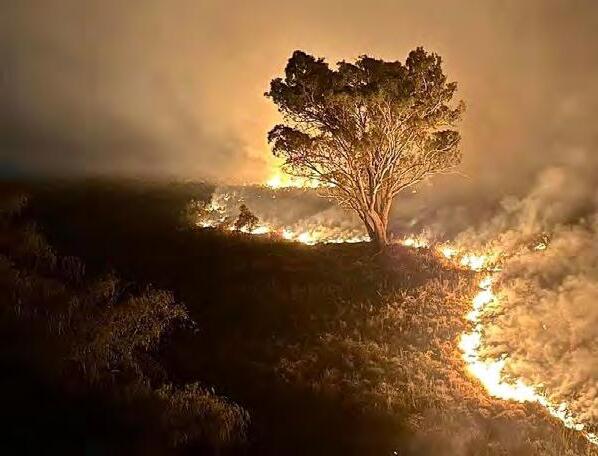
Superintendent Troy Porter, Cudgegong District Manager, recognised the importance of quickly notifying local residents about the fire.
“The community were immediately notified through messaging leading up to the weather event,” says Troy. “We held three community meetings at Hill End, Pyramul and Hargraves, with at least 220 community members attending.”
By Tuesday, under extreme fire conditions, the blaze was at Emergency Warning level and had spread in a number of directions.
“The prevailing weather situation was conducive to a fast-spreading grass fire, which eventuated,” says Troy. “I think most property owners were prepared, the only issue we had was that a large number of properties in the area were holiday homes or weekenders and no one was there.”
The countryside has long attracted visitors who have been inspired by the rugged and isolated terrain, such as artists Margaret Olley and Ben Quilty. Many tourists are also drawn to the historic gold mining town of Hill End and the Cornish Quartz roasting pits that were established in 1855.
“It was important to set up an asset protection zone (APZ) to assist crews in protecting the roasting pit site, luckily there was only minor damage to some
Photo: Scenes from the Alpha Road fire, Tambaroora.
Photo courtesy of Blue Mountains Strike Team.
2 BUSH FIRE bulletin || INCIDENTS
signage and fencing,” says Troy, who is one of many locals keen to protect the area’s heritage.
Despite the best efforts of firefighters, the fire surged to Emergency Warning levels several times as it threatened surrounding properties and villages. At least six homes and five outbuildings in the area were destroyed and a further nine damaged, with hundreds of Merino sheep and livestock lost in the blaze.

Over the following days, as the conditions intensified, aircraft were called in to assist. Sixty-four drops from three LATs and more than 900,000 litres of fire suppressants were delivered. Troy believes this was a turning point.
“The use of retardant lines and gel was crucial in steering the fire away from other vulnerable properties in grassland areas.”
By the end of March, after nearly four long weeks, the weather stabilised and the fire was finally listed as contained.
“Our crews did some great work managing the fire, with ground crews implementing containment strategies while being supported by heavy plant and aviation assets,” says Troy.
WHY ARE FIRES FUELLED BY CURED GRASSLANDS SO DANGEROUS?
Grass fires are different to bush fires and are generally less intense but equally as dangerous. Grass fires are unpredictable, start easily and spread quickly – they can move up to three times faster than bush fires. Fully cured grasslands can dry out rapidly and ignite within hours of rain ceasing.
Dead grass serves as a ‘flash fuel’, and grassy landscapes with high air flow provide plenty of oxygen to feed a fire. Resulting fires can be influenced strongly by changes in wind speed and direction, making them very dangerous and difficult to control on days of serious fire danger.
Grass fires can be ignited by lightning, arson and escaped burn offs. Once a grass fire starts, it can spread rapidly and ignite nearby vegetation, including trees and shrubs.
WHAT CAN WE EXPECT AFTER LA NIÑA WEATHER PATTERNS?
History shows that grass fires follow floods. During protracted La Niña periods since 1950 (1954-1957, 1973-1976 and 1998-2001) high vegetation growth led to extensive grass fires across Australia, followed by major forest fires.
Australia experienced the most widespread grass fires ever recorded in 1974-1975, with 117 million hectares burnt nationally, about 15 percent of Australia’s land mass.
Current weather models indicate that Australia will likely see a return to warmer and drier El Niño conditions towards the second half of 2023. El Niño is a naturally occurring climate cycle in the Pacific Ocean that brings hotter, drier conditions to eastern Australia, making droughts and bush fires more likely.
(Resource: Climate Council, Australia 2023)
BUSH FIRE bulletin || INCIDENTS 3
CANOBOLAS BANDS TOGETHER TO OVERCOME SEVERAL FIRES
The 2022/23 fire season proved to be very busy for the RFS Canobolas Zone Brigades. In the month of February 2023 alone, crews were actively involved in the Conimbla Rd fire northwest of Cowra and the Downs fire west of Manildra, while controlling a blaze at a waste recovery centre in Orange.
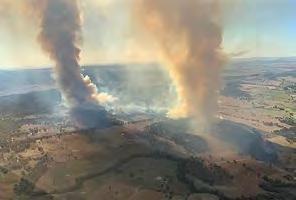
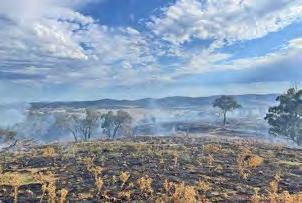
Started by a bee smoking device on 16 February, the Conimbla Rd grass fire was the most significant of these. It spread rapidly through the local area to a timber range and further west towards the Conimbla National Park.
Burning under power lines, and despite a rapid response from local brigades, aircraft and machinery, a Section 44 was soon declared. With unusual weather conditions that day, firefighters working on the ground experienced a weather phenomenon known as a fire-generated vortex or a fire whirl.
With reports of winds up to 200km an hour, the roof of a nearby brick house was blown off, collapsing two internal walls.
Debris was sent flying through the air and unfortunately some firefighters on the scene suffered minor injuries and were forced to dive for cover under trucks.
Although the crews had the fire under control initially, the strong winds caused the fire to jump containment lines and the hilly terrain presented significant difficulties for crews.
“It’s always challenging fighting these types of fires, due to the nature of getting vehicles in there and trying to keep the crews safe,” says Group Captain Stephen Hamilton, who is also part of the heavy vehicle truck mechanics team.
“It is paramount as a Group Captain to keep those involved out of harm, so if the fire has to burn another day due to that decision, then that is what happens.”
Significant fire activity continued over the next few days with additional resources deployed throughout the evening when the fire intensity increased.
Hard work by firefighters over the next few days and night, with tactical burns supported by aircraft and heavy plant, saw the fire finally listed as contained on 20 February.
A continued effort with patrolling, mopping up and blacking out hotspots continued throughout the next few days.
“It’s a significant benefit that we have access to aircraft who respond to fires so quickly – they play a key role in slowing the fires down once the retardant is dropped,” says Stephen.
4 BUSH FIRE bulletin || INCIDENTS
“This gives us more time to get through difficult terrain and put the fire out. In mountainous regions, we have to be mindful that it’s very possible for a fire to create its own unique weather pattern.


“In these situations, the task becomes much more difficult, which is what we saw happen in the Conimbla fire.”
Fire crews continued to work day and night shifts with the assistance of neighbours from the South West Slope Zone and a swing shift of five to six trucks, implementing tactical burns and supported by aircraft and heavy machinery.
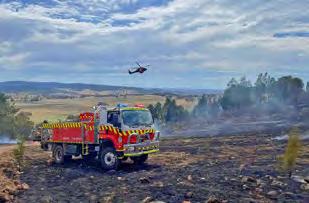
Stephen has enormous praise for the Canobolas Zone’s network of support.
“If we need a grader, fixed wing aircraft or more trucks, they make it happen. Communication is the most important aspect of fighting any fire, without that, we start losing crews,” he says.
“People, property and animals are our main concern and I am extremely proud of our community who are actively involved in keeping us safe.”
WHAT IS A FIRE-GENERATED VORTEX OR A FIRE WHIRL?
First verified in the 2003 Canberra bush fires, a fire whirl is a whirlwind induced by a fire and often composed of flame or ash. These start with a whirl of wind, often made visible by smoke, and may occur when intense rising heat and turbulent wind conditions combine to form whirling eddies of air. Creating a tornado-like vortex, these eddies suck in debris and combustible gases and can range in size from less than 30cm to more than 150m in diameter.
Top left: Aerial photo by Matthew Ross.
Centre images: Manildra fire. Photos by Will Marriott.
Top right: Conimbla Rd fire, image courtesy of Canobolas Zone.
BUSH FIRE bulletin || INCIDENTS 5
Right: Photo by Ned Dawson.
RFS WORKING WITH BEEKEEPERS TO ERADICATE VARROA MITE
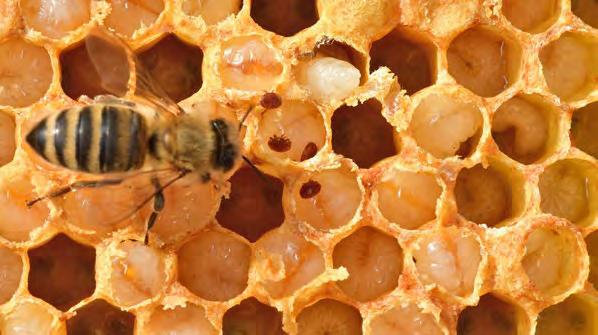
Varroa mite, a parasite which attaches itself to bees, was first detected in biosecurity surveillance hives at the Port of Newcastle in June 2022. Since then, the RFS has been working with the NSW Department of Industry (DPI) to protect the honeybee industry, as well as Australia’s food security, from the pest.
In July 2022, our volunteers and staff joined forces in and around the Hunter region to work towards eradicating the spread of the parasite.
Supporting the Incident Management Team (IMT) and field operations roles, strike teams were rallying to Orange in the Central Tabelands and Tocal, in the Lower Hunter, as well as assisting in Griffith.
In the IMT, the RFS played a primary role in operation, logistics and public information. There was also the opportunity for members, who successfully applied under an Expression of Interest (EOI), for temporary employment of up to six months.
A further EOI has seen additional temporary employment opportunities for members as a surge capacity workforce.
“During this period, thousands of hours of support from the RFS contributed to the containment of the Varroa Mite incursion. Under the guidance of the Department of Industry (DPI) and beekeepers, our volunteers and staff were assisting in the detection of the mites,” said RFS Chief Superintendent Laura Wythes.
“We are grateful to all of our RFS members who put up their hands to help and found the deployment so fulfilling, it has been a massive effort,” Laura said.
Superintendent Paul Best from the Hunter Area Command worked in a Public Information role, assisting DPI on and off over eight weeks.
RFS WORKING WITH BEEKEEPERS TO ERADICATE VARROA MITE 6 BUSH FIRE bulletin || FEATURES
“I was surprised by just how big the beekeeping industry is, from major industry leaders, to mums and dads at home.
RFS WORKING WITH BEEKEEPERS TO ERADICATE VARROA MITE
“I spoke to one person who has 5,000 hives and moves these around the country for pollination and then collects the honey for resale as an organic operation.
“We’ve made some great friends, it’s been a rewarding operation and we’ve achieved great results.”
Although the first Varroa Mite was contained, a new outbreak occurred in the Port of Newcastle and these parasites remain a biosecurity threat that is a significant risk to agriculture.

Management of the mite is challenging due to beehives being kept in a diverse range of locations. It is vital that beekeepers remain vigilant, register their hives and report any outbreaks to the Exotic Pests Hotline 1800 084 881 (9am to 5pm, Monday to Friday).

The Varroa Mite is a microscopic brown-red external parasite which debilitates and can eventually kill the honeybee. The mites attach themselves to the bee’s body and larvae and are highly mobile, easily transfering through contact or via beekeeping equipment.

HOW IMPORTANT ARE BEES?
As pollinators, bees play a vital part in every aspect of the ecosystem. They support the growth of trees, flowers and other plants that allow a diverse number of different species to exist. Studies suggest that bees help pollinate approximately 75 percent of the world’s flowering plants and 35 percent of the world’s food crops, including fruits and vegetables. Threats to the bee population would directly affect the availability and diversity of fresh produce, with nutrition likely suffering.
WHAT IS THE VARROA MITE?
Main: Bees in a hive with Varroa mites present. Top: Varroa mite surveillance operations in the field.
Photo by Daniel Osborne.
BUSH FIRE bulletin || FEATURES 7
Above: Staff and volunteers working out of the State Control Centre in Orange in August 2022. Photo courtesy of Dillon Jacombs.
FIRE TRAILS: THE FIRST LINE OF DEFENCE
The RFS Strategic Fire Trails Program is steadily transitioning fire trails in NSW from being simply roads in the landscape, to better maintained access roads which will suit firefighting operations into the future.

The RFS works closely with other agencies and land owners to improve and maintain fire trails and encourages ownership of fire trail maintenance at the brigade level.
Most fire trails traverse multiple tenures, including National Parks, Forestry Corporation, Crown Land, or private land. As part of the program, fire trail upgrades will now be certified to a consistent RFS Standard no matter who the land manager is. The RFS is also working directly with private property owners to ensure fire trails don’t stop on the boundary of private land.
Key areas of the program include identifying upgrades critical to firefighting, such as water points, potential staging areas, passing bays and turn arounds, all of which will appear on mapping via the new Mobile Data Terminals (MDTs) in appliances in the future.
Already, approximately 30,000km of strategic fire trail has been mapped as part of the Fire Access and Fire Trail (FAFT) planning process. For size comparison, there is only 20,000km of national, state, and local roads within Transport for NSW.
Fire trail upgrades are an expensive investment which will take time. Depending on the condition of the trail, simple upgrades can cost up to $10,000 per km with more complex projects costing up to $150,000 per km.
The project is working with local communities to prioritise trail upgrades where there is criticial infrastructure or it is the first line of defence for residential areas against a National Park, such as Bilpin in the Hawkesbury region where residents live between the Wollemi and Blue Mountains National Parks.
8 BUSH FIRE bulletin || GENERAL NEWS
The Bilpin Strategic Fire Trails program aims to permanently connect 75km of trails across hundreds of private properties and fringes of National Park.

As of June 2023, Stage 1 (12.5km between Kurts Road and Pitmans Road) has been completed and is ready for Certification, while Stage 2 (14km between Mountain Lagoon Road and Mount Irvine Road) is 90 percent complete. So far approximately $3.6million has been invested in these two stages.
The trails will provide significant community safety benefit in both mitigation activities and fire protection.
The local Hawkesbury RFS District has been championing this for a number of years, with volunteers, various community members and over 80 private landowners taking active roles and working closely with agencies including the NSW Soil Conservation Service.
Regular stakeholder meetings are held to ensure landowners are comfortable with the work being done, ensuring everyone’s voice is heard and everyone has a chance to ask and have questions answered.
The involvement of experienced RFS members including group officers is vital in developing future maintenance requirements.
Senior volunteers and local group officers being involved is vital, as we provide guidance about future maintenance requirements.
By building quality fire trails capable of supporting operations, we’re ensuring these trails can be used as firefighting assets to support RFS volunteers to do their jobs in a more safe and effective way.

WHAT ARE MOBILE DATA TERMINALS?
Mobile Data Terminals (MDTs) are touch screen tablets currently being installed in RFS vehicles that will enable two-way, real-time sharing of incident intelligence between members in the field and IMTs.
Features include crewing, map and navigation features including navigable fire trails, IAPs, BIRS forms and ability to view the ETA of other responding vehicles.
For more information about MDTs, read the article on page 16.
Main photo: Well constructed cross banks are critical for extending trail life and ensuring safe passage. Below: Swampy area bridged with rock armour to ensure access at all times. Photos courtesy of Jamie Carter.
BUSH FIRE bulletin || GENERAL NEWS 9
COMMUNITY WELLBEING INITIATIVE HELPS SURVIVORS
A new initiative called the Womens Validation Project has been set up in the Mid North Coast District to assist survivors of the 2019/20 Black Summer bush fires. Women can access health and wellbeing programs and reach out for support and professional services in relation to their experiences during the fires.
Lisa Hort, from the Rainbow Flat Brigade, has been instrumental in the new Manning Valley Neighbourhood Service project.
“Women have had the opportunity to participate in a range of diverse workshops; from mental health and wellbeing, story sharing sessions, creative hands-on lessons, to educational nature walks and Lifeline Accidental Counsellor Foundation training.”
Julie (pictured right) was a part of the Women’s Validation Project. She stands in her garden holding a photo of the cypress pine which burnt down during the 2019/20 fire season.
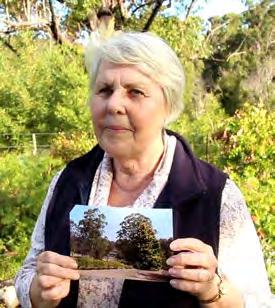
Listen to several of the women’s recovery stories from the 2019/20 bush fire season by scanning the QR code at right.
RFS ASSISTS WA’S BATTLES AGAINST FLOODS AND FIRES
During January this year, RFS members were joined by colleagues from NSW SES and Fire and Rescue NSW to work in several Incident Management roles in Western Australia.
On 15 January 2023, a group of RFS members travelled to Broome to assist during the Kimberley region’s floods. Further RFS personnel, part of a larger multi-agency team of 27, travelled on 25 January to work in Broome and the Fitzroy Crossing flooded areas. The teams engaged with isolated communities and assessed damage to properties and infrastructure to help with the recovery phase.
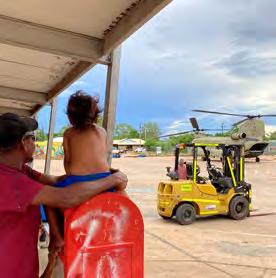
Following on from these successful deployments, the RFS dispatched the ‘Marie Bashir’ Large Air Tanker and Cessna Citation to Kalgoorlie on 22 February to assist with fighting a number of major fires in the state.
The LAT had also been in the United States in late 2022, providing assistance to the US Forest Service battling intense fire activity across several US states.
10 BUSH FIRE bulletin || INFOCUS
in FOCUS
DISTRICTS BENEFIT FROM TRUST FUNDING
RFS Districts across the state are beginning to see the benefits of grants totalling $18 million from the RFS and Brigades Donations Fund (the Trust). As announced last year, each District was eligible for grants of $400,000 to allow for major projects or the acquisition of larger assets that have broad benefits to many volunteers.
Some examples of assets acquired include new forklifts, gas car props for training, a new cab chassis and a purpose-built catering vehicle. For more information on the Trust funding, visit the RFS and Brigades Donations Fund community on One RFS.

FIRE AND CADET CHAMPIONSHIPS
The Australian Fire Cadet Championships will again be proudly hosted by the RFS and the NSW Rural Fire Service Association (RFSA) at AGH Camps in Douglas Park in the southwest of Sydney.

To be held from 25-28 September 2023, the event gives members the opportunity to compete, develop their skills and interact with other cadets from across the country.
This year’s Championships will accommodate a maximum of 26 teams. Each team will consist of six cadets (juniors) and two accompanying chaperones, being the Team Manager and Team Coach.
The Australian Fire Cadet Championships were first held in Penrith NSW in 2007, with twenty teams of cadet (junior) firefighters representing four Australian states competing.
These championships were such a success that it has now become a biennial event, attended by hundreds of cadets from around the nation.
Participation in this event is a unique opportunity for young members of fire and emergency services to come together in a fun and competitive environment and perhaps even take home the title of Australian Fire Cadet Champions.
BUSH FIRE bulletin || INFOCUS 11
UNDERSTANDING BLACK SUMMER THROUGH RESEARCH
BY BETHANY PATCH, NATURAL HAZARDS RESEARCH AUSTRALIA.
Science is shaping how Australia can better prepare for devastating bush fire seasons based on the major issues of the 2019/20 Black Summer fire season.
The Black Summer research program was undertaken by Natural Hazards Research Australia (formerly the Bushfire and Natural Hazards Cooperative Research Centre), drawing on the expertise of Australia’s best fire and climate scientists, human geographers, land managers and public health and recovery experts at 28 research institutions, First Nations organisations and fire and land management agencies.
The results summarise the findings from these many projects, including research in collaboration with the RFS.
This is vital information that presents a way forward from the fires, including exploring why the 2019/20 fire season was so devastating, what new capabilities can be implemented and how Australia can best learn from its worst fire season on record.
Insights from the research provide an up-todate scientific basis for decisions on how best to allocate resources, manage the environment and help communities prepare, respond and recover.
Some projects focused on what could be learned at a national level, while others analysed specific fire behaviour or technology in Queensland,
New South Wales, Victoria, South Australia and Western Australia.
“This is vital new Australian science about how to keep our landscapes and people safe from bush fire,” said Andrew Gissing, CEO of Natural Hazards Research Australia.

“Our fire seasons are getting longer and dangerous bush fire days are becoming more frequent. We need to be smarter and use this new scientific knowledge and research to improve the ways we live with fire.”
The research has improved our understanding of how the extremely dry conditions and recordbreaking temperatures impacted our weather in ways that previously were not as well-understood.
With better bush fire modelling, better warnings, better land management and better recovery after a disaster for those affected, we improve our chances of avoiding a catastrophic event in the future.
Understanding the Black Summer Bushfires Through Research can be viewed by scanning the QR code here:
Photo by Ned Dawson.
12 BUSH FIRE bulletin || RESEARCH AND TECHNOLOGY
FOUR FLOODS IN FOUR MONTHS
BY ANDREW MACDONALD, GROUP CAPTAIN, MACARTHUR DISTRICT.
2022 was a year of devastating floods for eastern NSW. The township of Camden, on the southwest fringe of Sydney, was affected by floodwater four times between March and July. While the flood impact on the Camden community was nowhere near as devastating as in other areas of the state, the RFS response and assistance with recovery efforts was still significant.
Camden is the first town that can become flood-impacted by heavy rainfall in the upper Nepean River catchment. Here, it can take less than a day of high rainfall in the catchment to cause significant flooding.
This provides limited preparation time for local residents, businesses and emergency services. Fortunately, the Nepean River at Camden is not tide-affected so floodwaters tend to recede rapidly once rainfall reduces.

During the floods, RFS crews assisted NSW SES with rescues, evacuations and general community doorknocking. Once floodwater began to recede, RFS volunteers assisted residents and business owners by moving flood-impacted contents and hosing out properties.
The floods saw crews dealing with hazards including contaminated water, dead animals, angry snakes and unusual debris suspended in trees and on roofs.
By working closely with Camden Council to clear major roads and bridges, the RFS was able to help restore some normality to the community,
Out-of-area requests came a few days later to help in the Hawkesbury and Hills areas.
During the flood in early July 2022, floodwater rose two metres above the bowling greens at Camden Sports Club. The next day, as floodwater began to recede, RFS crews worked during heavy rain to pump the residual floodwater off the bowling greens and assisted with the removal of mud and silt.
Not only did this save the bowling green surface, but it allowed the lawn bowlers to return a week later as if the flood hadn’t occurred.
Another important role saw the RFS assist other community groups deal with the impact of flooding. Camden RSL, the Show Society, Lions Club, Men’s Shed and numerous sporting groups including cricket, tennis, little athletics and softball have all been assisted by RFS volunteers multiple times last year.
By working closely with other agencies and the local council, our volunteers have helped deliver a great result to the greater community of Camden.
Photo by Andrew Macdonald
BUSH FIRE bulletin || INCIDENTS 13
BRIDGE OVER TROUBLED WATERS NEAR FORBES
In October and November 2022, Forbes was one of many towns in NSW affected by flooding. During this time, for workers like nurses, teachers and farmers, the RFS was a bridge over troubled waters.
The Lachlan River flows through the Mid Lachlan District, and many communities in the area are subject to a pattern of regular flooding that isolates small villages such as Bedgerabong. Without shops or facilities, this small farming community is reliant on road access to neighbouring towns for supplies and community services.
During a flood, the RFS can assist by using a Cat 1 to drive through the generally slow-moving floodwaters due to the height and four-wheeldrive capability of the vehicle.
Ronald Hocking, Captain of the Central Forbes Brigade, is one of the original members of the Brigade and has been with the RFS for 33 years. As a retiree, Ronald enjoys lending a hand, and during the flooding his services were in high demand to help people get medical attention or get to and from work.
“The work is varied, from helping a farmer who needs to access his sheep, to transporting a nurse and her two children.”
Ronald often picked up members of the community in the morning and drove them home in the evening. “Once we picked up a woman with
an unwell child at Bedgerabong and brought her into Forbes for a blood test.”
The neighbouring Yarragong Brigade also played an essential role in supporting Bedgerabong during the floods. Their Captain, Andrew Barnard, delivered teachers to Bedgerabong Public School for months.

Like many members of the RFS, Andrew is self-employed and takes time out from his own business to contribute to his community.
His main job was to take the teachers to Bedgerabong, “We took three to four at a time, picking them up from Yarragong station, which is 17km northwest of Bedgerabong and delivering them to the school.”
• A small rural township situated 32km west of Forbes.
• Located 330kms from Sydney covering an area of approximately 136 square kilometres.
• Bedgerabong has a population of 149 residents.
14 BUSH FIRE bulletin || INCIDENTS
Some days or weeks, Andrew went alone and other times volunteers had availability to share the load.
“Helping out so that kids could keep learning and teachers could keep teaching is just part of being a volunteer,” Andrew said.
Paul Faulkner, Principal of Bedgerabong Public School, is grateful to the RFS for their commitment to get stranded local families into the school.
“Our teaching staff were taken to work so that they could continue face-to-face learning, which occasionally took up to two hours a round trip.
“We said a few times to the RFS, ‘if this isn’t working, we’ll find another way’. Inevitably they always came back and said, ‘no we’re here to help’.”
The township of Bedgerabong are all very appreciative to the RFS volunteers who made every effort to support the community by keeping normal school routines for the children.
“It was an amazing commitment, illustrating their dedication to others, especially given that Bedgerabong isn’t their immediate community,” said Paul.
“We thank all the RFS volunteers like Ronald and Andrew, who continued to be there for us day after day, working behind the scenes making a real difference to our little school.”
Late last year, central NSW had one of the largest ever emergency flood responses in the state’s history.


Communities saw 17 warnings in place and eight major flood warnings affecting 25 locations in the area.
Many residents were evacuated or stranded, needing assistance.
 LACHLAN RIVER FLOODING
LACHLAN RIVER FLOODING
BUSH FIRE bulletin || INCIDENTS 15
Main photo: courtesy of Ronald Hocking. Above: Both photos district images.
MOBILE DATA TERMINALS: A NEW WAY OF COMMUNICATING
Mobile Data Terminals (MDTs) are currently being installed into RFS appliances and will be instrumental in enhancing current incident management practices.
The installation of MDTs is one of the Service’s priority projects, enabled by public donations to the Rural Fire Service and Brigades Donations Fund. MDTs will improve the way information is received and assist in making faster decisions during fire events.

Importantly, the new technology will not replace the vital role radios play within RFS. Instead, radio traffic will be significantly reduced due to incident information being readily available via MDTs in the field. This will allow radio communications to be reserved for urgent or critical intelligence.
“The RFS understands the need for better and more modern communications equipment, so we can deal with future environmental conditions and continually enhance our operational response,” says Peter McKechnie, Deputy Commissioner Field Operations.
“MDTs provide a significant opportunity for the Service to review its current incident management operating model, in line with the recommendations from the 2020 NSW Bushfire Inquiry.”
Some of the key benefits and enhancements from MDTs include:
• two-way, real-time sharing of operational intelligence between members in the field and Incident Management Teams (IMTs)
• access to a single source of incident information, improving pre-incident preparation and informing actions by crews and strike teams
• integration with existing RFS systems, to improve dispatch and response capability

16 BUSH FIRE bulletin || RESEARCH AND TECHNOLOGY
The first four districts to receive MDTs will be the Far South Coast, Central Coast, Cudgegong and Lake George, with installations to start in September 2023.
Troy Gersback, Operational Officer Level 3 in Cudgegong, has been involved in the MDT rollout program. “MDTs will enhance our ability, both as firefighters on the ground and Incident Management Personnel in Fire Control Centres, to send and receive up-to-date, real-time intelligence,” says Troy.

“Being able to have the incident details at your fingertips and the ability to see the incident log will be a huge step forward for situational awareness.

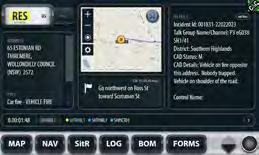
“This information was previously only held by District Officers or the Operational Communications Centre and communicated via radio.
“The Command and Control function will be a great tool for our Field Commanders and I look forward to the information available on MDTs allowing a reduction in briefing times, enabling crews to maximise their time on the ground.”
SCAN the QR for more information on how MDTs will enhance operational responses at the One RFS MDT Project.
Main image: A Mobile Data Terminal (MDT) installed into a Service appliance. Above and previous page bottom: Video stills from the MDT video shoot in Bargo. Below: In these examples, the screen shots show different ways the MDTs will benefit RFS brigades.
Bottom left: Viewing incident information, including current status, incident address and type. Bottom right: Accurately recording who crewed the truck.
BUSH FIRE bulletin || RESEARCH AND TECHNOLOGY 17
FOCUSING ON WHAT MATTERS MOST
In July 2020, Commissioner Rob Rogers announced a set of priorities for the Service following the devastation of the Black Summer fires of 2019/20. Building on the successful roll-out of those first priorities, new priorities were identified for the RFS. The new priorities continue to align to our strategic direction, and place focus on projects that will make a tangible difference to members, allowing them to operate safely and effectively, and connect and work together to best serve the community.
BENEVOLENT FUND
One of the Commissioner’s priorities is to better support our members when they need it most. With this in mind, the RFS has been working to establish a fund that will benefit those who require help within the organisation.
The Benevolent Fund is set up to distribute money to injured or deceased firefighters and their families. This is a step towards our longer term vision, to provide broader support for RFS families suffering from financial distress and hardship.
With approval from government to progress and significant donations from the NSW Rural Fire Service and Brigades Donation Trust, the Benevolent Fund will be established this year.

STATION CONNECTIVITY
The RFS is dedicated to improving communication between brigades and the Service through internet connectivity, ICT equipment and software updates. In February, the RFS began rolling out free Nighthawk routers (with a SIM card included) to any brigade that wished to receive one. This solution will not only deliver improved internet speeds, but with new mobile routers and internet plans, brigades will no longer be required to source and pay for their own internet connection.
The Nighthawk routers are the first phase of the project, and the RFS is currently investigating what other connectivity equipment would be beneficial to our members and how best to implement it.
Brigades who want to be involved can find more information by scanning the QR Code (right), or by emailing ictpmo@rfs.nsw.gov.au
18 BUSH FIRE bulletin || PRIORITIES
WORKPLACE CONDUCT
Following substantial consultation with members and work to date, the new Workplace Complaints Resolution Framework is due to roll out in the second half of 2023.
The framework will provide processes and tools for raising, responding to and resolving workplace complaints in a transparent, timely and fair manner. It is designed to encourage our people to speak up about workplace conduct concerns and to promote our culture of inclusivity and respect and will be made available to all RFS members.
Our focus is not only our reputation and the protection we provide to the communities we serve, but the compassion and support we show our members.
We thank those members who recently gave feedback on the proposed initiative, with more than 80 percent of respondents indicating that the proposed framework was an improvement on the existing structure. We look forward to the positive outcomes that this new approach will bring.
NEXT GENERATION FLEET
A key area of research within the RFS is in identifying what our firefighting fleet of the future should look like. We have been asking members and the industry for ideas and suggestions on our Category 1, 7 and 9 tanker design, their current suitability and features that could be improved in future models.
The feedback we receive is vital, as it gives the RFS direction. To design the best next generation fleet, it’s important that we understand the views of our members about our current fleet.
To this end, the Service released an online survey and held in-person feedback sessions all over the state with members.
The survey and sessions focused on three main areas of the truck: the comfort, connectivity and technology of the cabin; the configuration and content of the tool box; and the capability of the vehicle in pumping performance, off-road driving and protection.
We thank all the thousands of members who participated in the survey and feedback sessions, your insight will help us to deliver the next generation fleet for members.
Members will get regular updates on these projects via One RFS, the eBulletin and RFS Connect.
SECOND SET OF PPC
Although many Districts have already provided a second set of Personal Protective Clothing (PPC) for their members, the RFS is now ensuring that all operational members across the state are given the opportunity of a second set of bush fire PPC.
The Service is making available a second Wildland jacket and Wildland cargo trouser or over trouser to all members.
Members who already have a second set of PPC are still encouraged to fill out the form (accessible via the QR code below) to record their sizing for other items of PPC, so that we can store the data for future use.
You will need your eight-digit membership number to place an order – if you don’t know your membership number, you can check it by logging into the Member Portal or speaking with your Brigade leadership team.
Once you submit the form, it will need to be approved by your Brigade Captain and reviewed by your District office before orders are placed and managed by the RFS Logistics team. To access the form, please scan the QR code (right).
RFS BRANDING
You may have recently seen some minor changes to the way the RFS is promoted in the community.
The changes include:
• Using ‘RFS’ only in most of our materials, instead of ‘NSW RFS’ or ‘NSW Rural Fire Service’
• Progressively updating the look and feel of our corporate designs, with changes made to our templates and resources
• Improving the accessibility and consistency of materials Importantly, these changes are being made at no cost. This means that we will update and replace items as they’re required to be produced or replaced. There is no need to replace existing items simply because of branding.
For now, you can start using RFS in your written and online materials, and we’ll be providing access to new or updated materials as they become available.
We’ll also be updating our guidance to members in the near future. If you have any questions or want more information, email comms@rfs.nsw.gov.au
BUSH FIRE bulletin || PRIORITIES 19
extraFOCUS
RFS TO ROLL OUT FIREMAPPER
In late 2023, the RFS plans to roll out FireMapper as a preferred infield mapping solution.
FireMapper is already used by many brigades and has been trialled and tested as a user-friendly and effective mapping application, best meeting operational requirements.
The RFS is committed to finding more efficient ways to equip and serve the community. This involves finding modern, cutting-edge and fit-for-purpose technology that can help serve the Service’s purpose.
As a priority project, Infield Mapping is critical for improving in-field situational awareness and operational decisions, playing a major role in how the RFS respond to fire incidents, support members in the field and keep communities safe.
PHASED FIREMAPPER ROLLOUT
During the first phase of the project, the RFS will roll out the enterprise version of the app, already used by some brigades. Members will receive basic training and information, so they can start using the app, make themselves familiar with it and explore its potential.
The aim is for members in the field to be able to annotate directly on maps to gather and distribute fireground intelligence.
Members will have the ability to share map annotations from personal devices with other FireMapper and Mobile Data Terminal (MDT) users, making it possible for members and brigades to collaborate. Where required, map annotations can also flow into COP, ensuring that Incident Management Teams (IMTs) and other government agencies have real-time access to incident information.
Following the initial rollout of FireMapper, the RFS plan to customise the app to the Service’s requirements and fully integrate it with other operational systems.
The rollout schedule will be finalised soon and will be communicated to the relevant brigades in due course. Existing FireMapper customers will be automatically transitioned to the Service-funded platform as part of the initial rollout.
 Photo background: Green Valley Talmalmo fire 2020.
Photo by Seth Wilmot. Phone image courtesy of Fire Front Solutions
Photo background: Green Valley Talmalmo fire 2020.
Photo by Seth Wilmot. Phone image courtesy of Fire Front Solutions
20 BUSH FIRE bulletin || RESEARCH AND TECHNOLOGY
RFS MEMBERS ANSWER
THE CALLS TO HELP OUT NSW SES
In October 2022, as flooding in various parts of the state increased, the NSW SES was experiencing unprecedented requests for assistance. Luckily, RFS members were happy to step in and provide help answering calls at the NSW SES call centre in Wollongong.
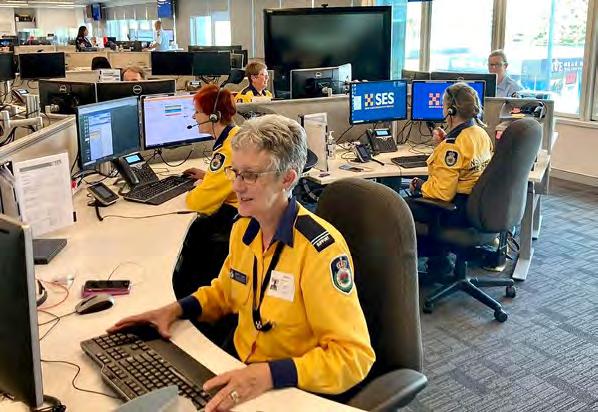
Six volunteers from different brigades were trained up in the use of the NSW SES’ Beacon system and then completed two 12-hour shifts onsite.
Working from 0900hrs to 2100hrs, Cassandra Philpot of the Lake George Communications Brigade assisted in managing the large number of calls coming from all across the state.
Helen Wrightson, also from the Lake George Communications Brigade, was a supervisor on the radios during the 2019/20 bush fires.
“As the primary skillset is being able to receive calls from the public and deal with people professionally, we already had the foundations to help out,” says Helen.
“Of course, flood rescue is highly time-critical, so these calls went to specialised operators.”
Helen remembers her time during the 2019/20 bush fires as call after call with no break.
“When people’s lives and properties are at immediate risk and you need to supervise, the work is exhausting and relentless,” she says.
“But in each situation you know you’re part of a team that’s doing something bigger and people are very appreciative.”
Dianne Knight from the Blue Mountains Group Support Brigade was another member lending a helping hand.
“Moree, Griffith and Narrabri community members were struggling quite a lot with getting groceries,” Dianne recalls.
“In Bringelly, there was a tree down which crushed three cars, although thankfully nobody was hurt. It was a great team effort during those 12-hour shifts and it was interesting to learn how their systems compared to ours.”
Thank you to all the members who volunteered their time to help out the NSW SES.
Photo: RFS members at NSW SES HQ in Wollongong
BUSH FIRE bulletin || OPERATIONS 21 BUSH FIRE bulletin || INCIDENTS 21
A GLIMMER OF HOPE AFTER THE FLOODS IN EUGOWRA
After a night of torrential rain, the residents of Eugowra were woken on the morning of 14 November 2022 to find the Mandagery Creek that runs through town had risen to dangerous levels. At 0700hrs, farmers witnessed a massive volume of water coming from the east through rural paddocks. An enormous surge was heading towards the town of Eugowra.
By 0900hrs, the floodwaters had wiped out the surrounding canola crops and were continuing to increase in severity.
The community had prepared for flooding but not to this scale. The main street soon turned into a raging river, engulfing the town and bursting through all the buildings. Power was cut and many people were stranded. Flash flooding had inundated ninety percent of the Eugowra township.
By 1000hrs, a full-scale operation was underway and aviation rescues were in place. Despite the horrendous conditions on the day, the RFS Aviation Rescue Crews performed 71 rescues to help trapped residents on their rooftops.
Local RFS units utilised heavy fire tankers to rescue people trapped in their homes as evacuation was impossible by normal means.
Eugowra Brigade Captain Bill Turner lost his house, business, car and his belongings while assisting with rescues.
“There was a metre of water ripping through the centre of town. My shop and all the machinery were damaged and at home, the kitchen, all of the furniture and our clothing was destroyed,” says Bill.
“Houses and cars were being swept away. In the clean-up, everything had to be stripped out, because flood water is contaminated. We lost everything.” Catchments filled up so quickly overnight that many residents were not prepared and unfortunately, the Eugowra Brigade station was also destroyed. Overwhelmed by the scale of the damage, local RFS members had no way of salvaging what was left.
However, their spirits were lifted by the announcement in January 2023 of $1,000,000 in funding from the NSW Government. Allocated to rebuild the station on higher ground, the brigade will be able to continue to serve the Eugowra community.
Brett Bowden, Canobolas District Manager, spoke to the many local RFS members who are overjoyed at the prospect of getting a new facility after an enormous clean-up.
“With the sort of devastation the town has seen and the budget that has been announced, the community can look forward to a brighter future,” says Brett. “Good things come from bad things sometimes, and in this case, it will be a wonderful positive outcome for the town.”
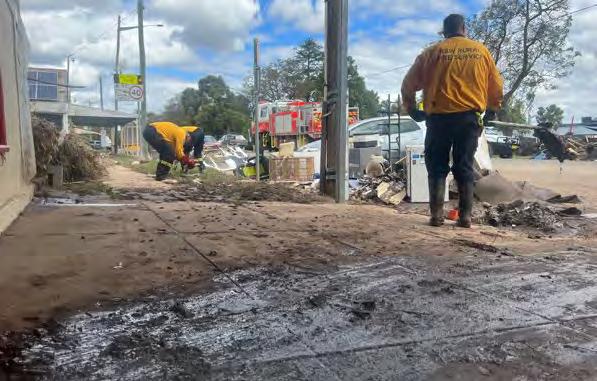 In November 2022, a severe flash flood impacted the small town of Eugowra in the Central West, destroying many homes, businesses and the local RFS station.
In November 2022, a severe flash flood impacted the small town of Eugowra in the Central West, destroying many homes, businesses and the local RFS station.
22 BUSH FIRE bulletin || FEATURES
UPDATE IN EUGOWRA
Rebuilding has been slow in Eugowra due to the size of the clean-up, insurance issues, Council approvals and availability of trades. Almost every house in the eastern part of the town was affected by floodwater and many homes were washed off their foundations.


With a disaster such as this one, only a third of the pre flood population have remained, others have sought accommodation elsewhere with family or friends. The NSW Government have provided accommodation pods for those who have stayed and are waiting to rebuild.
“It will be more than 12 months from now, perhaps even two years before Eugowra is back to anything resembling normal,” says Brett.
“It’s been tough, many businesses have not yet reopened due to significant damage.”
The community are appreciative of the support and donations received since the floods.
Discussions are now underway with Cabonne Council, NSW Lands Office and the Canobolas Zone for the rebuild of the RFS station which will be close to the Showground Precinct.
WHY DO INLAND FLOODS HAPPEN?
During a La Niña weather cycle with more intense rainfall, catchments become wetter. When the land becomes saturated, the excess water flows into river systems and can cause them to exceed their capacity. This causes the water to flow into the low-lying areas and can result in flooding.
Images: Local RFS community members assist in the clean up of Eugowra township after the devastating floods.
BUSH FIRE bulletin || FEATURES 23
Photos by John Healey, Bas Bobeldijk and Ben Chai.
RFS LAUNCHES MENTAL HEALTH STRATEGY FOR 2023-2027
Within the RFS, we are committed to supporting the mental health and wellbeing of our members.
The strength of any organisation absolutely lies in its people. This is never more evident than in emergency service, volunteer-based organisations. As well as protecting the community and our environment by minimising the impact of fire and other emergencies, we also need to protect our members.
After consulting with our volunteers and staff to gain a better understanding of key mental health risks from their perspectives, the Service sought to understand how we could offer better support.
With this in mind, Commissioner Rob Rogers recently launched the RFS Mental Health Strategy for 2023-2027 as a key priority project.
The Strategy will guide our actions over the next five years to create and maintain a mentally healthy environment where our members can thrive.
WHY IS HAVING A MENTAL HEALTH STRATEGY SO IMPORTANT?
RFS members play a critical role in keeping communities safe, and this can increase their risk of experiencing poor mental health.
The Strategy has been created in recognition of our responsibility to provide a safe and inclusive workplace and responsibly manage the mental health risks our members face.
With mounting societal pressures, unique workrelated risks and the increased prevalence of mental illness, it is imperative that we proactively foster a mentally healthy environment where our members can thrive.
How do we create and maintain a positive environment for our members?
• Prevention: protecting mental health by reducing work-related risk factors and enhancing protective factors
• Promotion: promoting mental health by developing the positive aspects of work as well as member strengths and positive capacities
• Response: supporting members who are showing signs of mental health issues through a stepped care approach
• Recovery: providing intensive person-centred treatment to support recovery from mental illness and return to work or transition opportunities
WHO ARE THE SUPPORT SERVICES AVAILABLE TO?
The mental health support services are available to all our members and their families.
WHAT TYPES OF SERVICES ARE AVAILABLE?
Within this strategic program there will be a number of specific areas in which the RFS will offer professional mental health support and formalised programs. These include:
• Peer support programs
• Area based psychologists
• Chaplaincy and family support
• Member assistance programs
24 BUSH FIRE bulletin || FEATURES
Photo by Conor Deans
WHAT CHANGE WILL MEMBERS EXPERIENCE?
• Mental health services will be more accessible, more aligned to member needs and work seamlessly together
• Pathways to care will be clearer so members and their families can identify when, where and how to seek support
• Health and injury management support will better assist members to recover from illness or injury and reduce the likelihood of secondary psychological impacts
• Fit-for-purpose training and education will be available to equip members to look after their mental health and that of others
• Suicide awareness programs will be made available so members can identify and respond to early indicators of suicide risk
• Leaders will be equipped to support their own and their team’s mental health and effectively manage mental health risks
• Psychosocial risks will be systematically identified and managed to help protect the mental health of our members
• The goal over the next five years is to create a mentally healthy environment where we help our organisation be well, help our leaders lead well, help our members stay well and help our members return to well
The responsibility for health and safety is a shared one. Mental health alongside physical health is fundamental to a safe workplace.
We all have an important role to play in building and maintaining a mentally healthy environment. Let’s work together to strengthen our organisation, supporting our leaders and each other into the future.
All RFS members are encouraged to check out the Mental Health Hub on One RFS where you can not only download the full strategy and the one-page summary, but also find out how to get mental health support and access the resources you need.
DON’T BE AFRAID TO ASK FOR HELP! If you or someone you know needs help, or someone to talk to, contact:
MENTAL HEALTH SERVICES: mental.wellbeing@rfs.nsw.gov.au

MEMBER ASSISTANCE PROGRAM (MAP): 1300 360 364
CRITICAL INCIDENT SUPPORT SERVICES
(CISS): 1800 049 033
LIFELINE: 13 11 14
BUSH FIRE bulletin || FEATURES 25
MENTAL HEALTH STRATEGY 2023-2027
I N BR IEF
Ou r Commi t men t





The RFS is committed to supporting the mental health and wellbeing of our members. This is why we’ve developed our Mental Health Strategy – to provide a roadmap for action over the next five years to achieve our goal of a mentally healthy environment where our members can thrive.
The Strategy has been shaped by an integrated Mental Health Model (Prevent, Promote, Respond, Recover) which aligns to industry best practice and the needs of our members.
How w ill this help mem ber s?

We will increase accessibility for members and their families and clearer pathways to mental health support.
We will have an organisational focus on identifying and managing mental health risks to protect our members.
We will improve our injury management processes to better support members in their recovery.
We will provide more opportunities for mental health training and education including suicide awareness programs for members.
We will build the capability of leaders to support their own mental health and the mental health of their teams.
Read the entire Mental Health Strategy on One RFS or contact the Mental Health Services team. Scan here for more details:
PROMOTE RECOVER PREVENT RESPOND
Mentallyhealthyenvironment w here our memberscanthrive
STRATEGIC OBJECTIVE 1
Helping Our Organisation Be Well
Creating better systems, processes and programs to protect members’ mental health
STRATEGIC OBJECTIVE 3
Helping Our Members Stay Well
Equipping our members with the right knowledge, skills and abilities to take care of their mental health and the mental health of others
STRATEGIC OBJECTIVE 2
Helping Our Leaders Lead Well
Providing our leaders with the support to foster a mentally healthy environment
STRATEGIC OBJECTIVE 4

Helping Our Members Return to Well
Strengthening and uniting our services to provide the best mental health support for our members
2023-2027
THE G O AL
RFS-LED INITIATIVE TACKLES
ARSON ATTACKS IN WESTERN SYDNEY
PARKLANDS
Within a four-week period in mid-2020, the Plumpton Brigade received 23 calls of suspicious fires of unknown origin in the Western Sydney Parklands area. These fires were usually being lit between 2.30pm and 4.30pm in the afternoon.
Police finally apprehended a young teenager lighting a fire in Western Sydney Parklands in July 2020. At this time, Plumpton Brigade Captain Phillip Cook and other brigade members had realised that a possible solution to the problem could be through an education intervention.
The ‘Guardians of the Park’ initative was trialled in 2022, aiming to increase awareness of fire and the environment among young people in the area and strengthen community relations.
Pupils from the local Coreen School in Blacktown took part in the initial trial session at Bungaribee, Western Sydney Parklands, where they learnt about the role of fire in the landscape, wildlife conservation, and gained an understanding of indigenous culture and fire knowledge.
The RFS Cumberland District provided appliances, staff, and volunteers.
Planning for the project, led by Greater Sydney Parklands and involving various stakeholders including NSW Police, the RFS and Murru Mittigar Aboriginal educators, began in 2021.

The project was delayed by the flooding events of 2022 but finally commenced in June of that year, with Phillip Cook helping to lead the sessions.
“Our part in this was to speak to young people on how to protect themselves in the event of a fire, and the impact that fire has beyond burning vegetation,” says Phillip. “At first, I think they were seeing us as authority figures and were a little reluctant to get involved, but when we took off the yellows and just put on a normal tee-shirt, that seemed to break down a few barriers.
“The idea is not for the RFS and the police to catch and penalise, but to help young people move in a direction that is better for them, to faciliate learning about fire, and hope that this will lead to a sense of ownership of their environments.”
Following positive feedback from pupils and teachers, Western Sydney Parklands have secured funding to run the program across a much larger number of schools and pupils in the years ahead, with a program targeting Year 9 and 10 students.
“It’s always better to involve the community and bring them with you rather than punish them,” says Phillip.
“This program will be really beneficial as it gives young people a relationship between themselves and their surroundings, and encourages an appreciation of their environment.”
Photo: Western Sydney Parklands, Future Seven Ridges Walk. Photo by Daniel Tran.
28 BUSH FIRE bulletin || GENERAL NEWS
FIRES NEAR ME BECOMES HAZARDS NEAR ME
For more than a decade, the RFS Fires Near Me app has been a trusted source of information about bush fires in NSW. In early 2023, the app was upgraded and expanded to show flood and tsunami incidents as well as fires, with flood incident information provided by the NSW SES.
The 2022 NSW Flood Inquiry highlighted the need for more emergency information to be available to the community in a multi-hazard app.

Expanding on the existing Fires Near Me app was a natural solution, allowing the NSW Government to build upon the success and user base already in place.
The new app may look a little different to users, with the existing fire icons appearing in addition to flood and tsunami icons and warning zones. It is also now possible to receive notifications about fires, floods and tsunamis in your area by setting up multihazard watch zones.
Hazards Near Me NSW complements the suite of information tools already available to the public, including the RFS website, 1800 Bush Fire Information Line and social media channels.

Over time, more hazards and additional features will be added to the app.
If you already have Fires Near Me NSW on your phone, you can update it through your App Store or Google Play.
If you don’t have Fires Near Me NSW, search for ‘Hazards Near Me NSW’ in your App Store.

BUSH FIRE bulletin || GENERAL NEWS 29
INDIGENOUS ART A PROUD NEW FEATURE OF BELLBROOK TRUCK
The Bellbrook Brigade in the Lower North Coast District recently commissioned an artwork from local Indigenous artist Elwyn Toby, who is also a long-term brigade member, which is now featured proudly on their fire appliance.

A great way to strengthen the connection between the RFS and local Indigenous community, the artwork ‘First and Last Defence’ was completed and applied to the Bellbrook Brigade’s truck in time for NAIDOC Week 2022.
Once the plan was approved by Aunty Ruth, a local Elder and member of the Thungutti Local Aboriginal Land Council (LALC) board, Elwyn spent about two months creating the artwork.
He has been an artist for 15 years, a member of Bellbrook Brigade for 10 years and is also a teacher of Cultural Arts at TAFE.
Elwyn’s primary source of inspiration was the way the Brigade managed severe bush fires in 2019, when unprecedented conditions over large areas of the Lower North Coast led to widespread damage through the Bellbrook area.
Bellbrook was evacuated and cut off for ten days with no power, landline or mobile service, which presented a raft of challenges for those who stayed and fought the fires.
“The artwork is about water, it’s the first defence and the last defence,” explains Elwyn. “Essentially, the water feeds the community, and it’s also the source to fight the fires.
30 BUSH FIRE bulletin || FEATURES
“The little red dots are the spot fires we’re fighting, and in the centre there’s the fire truck. This is the best defence for the community. We look after one and all, essentially.
“I made the artwork but really it is about, and inspired by, the team effort during that time in 2019,” says Elwyn. “So that’s what you see – how we reacted and how we fought the fires.”
The Bellbrook Brigade feels a strong sense of pride for the contributions they make to their community through the RFS, as well as for their connections to Indigenous history.
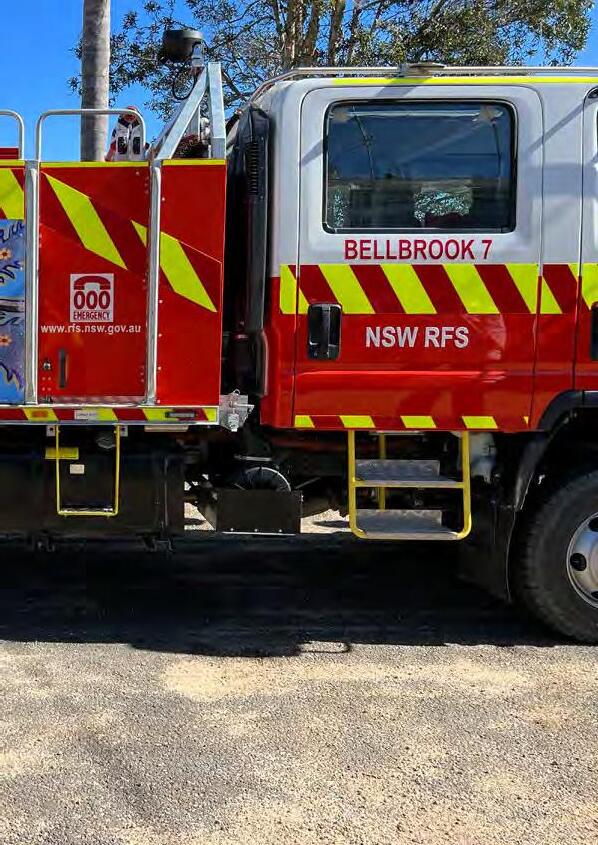
The next project the brigade will be working on is the restoration of their old Bedford Fire Tanker, understood to have been used by the first allIndigenous fire crew in Australia.
“We discovered the tanker when the Captain of nearby Newee Brigade, Morgan Fraser, was driving through a place called Tamban. He saw the truck sitting on a private property with ‘Bellbrook’ on the side of it,” says Elwyn.
“We did some fundraising and got hold of it. We’ve already started trying to get the engine running, and we’ve got a plan in place toward restoration. We believe it was the vehicle of the first all-Indigenous RFS crew, so we have a sense of pride about keeping that within our own community.”
More information about Elwyn Toby and his artworks can be found on the official home page of the Dunghutti-Ngaku Aboriginal Art Gallery, at dnnag.com.au
BUSH FIRE bulletin || FEATURES 31
Photo: Adam Hall and Elwyn Toby pose beside ‘First and Last Defence’. Photo courtesy of Narelle Jones.
SUN COMES OUT FOR RFS STATE CHAMPIONSHIPS
More than 350 of the state’s finest volunteer firefighters were put to the test in September at the 25th RFS State Championships at Bulli Showgrounds.
Volunteers from across the state descended on Wollongong for two days of competition across a range of challenging, real-life scenarios. Volunteers competed in a series of simulated emergency situations and were scored throughout.

After months of torrential weather, the sun came out for the weekend. A total of 13 senior teams and eight junior teams competed in a range of scenarios from simulated motor vehicle accidents and navigation, to bush, grass and structure fires.
Firefighting teams were tested on their leadership, teamwork, adaptation and decisionmaking abilities.
A standout event of the Championships was the ‘Eat Street’ Catering Challenge where Catering Brigades from across NSW competed to be crowned ‘Best in the State’.
As expected, the range of food was amazing and competing firefighters were well-fuelled for the days of competition.
There were also 20 exhibitors set up with interactive displays and new, exciting products on show.
The Championship Principal Partners, Gilbert and Roach Huntingwood and Isuzu Trucks, presented the winners of the 2022 State Championships at the end of the event.
Congratulations to Oakville Brigade from the Hawkesbury District who were overall winners for the senior events, for the third year in a row.
Congratulations also to St Paul’s Cadets who were the overall winners for the junior events. The next State Championships will take place in Albury during 2024, so keep training and keep your eye out for information about joining.
32 BUSH FIRE bulletin || GENERAL NEWS


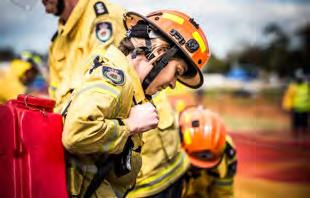


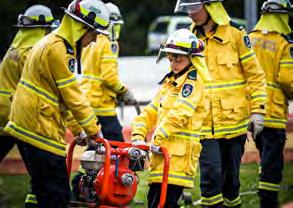


BUSH FIRE bulletin || GENERAL NEWS 33
Photos by Sharon Quandt
STARS SHINE BRIGHT IN BUNGOWANNAH
Theresa Star is not only the third generation of Stars to head up the Bungowannah Brigade, following in the footsteps of father Graham and grandfather Don, she is also the first woman to captain a brigade in the Southern Border Team.
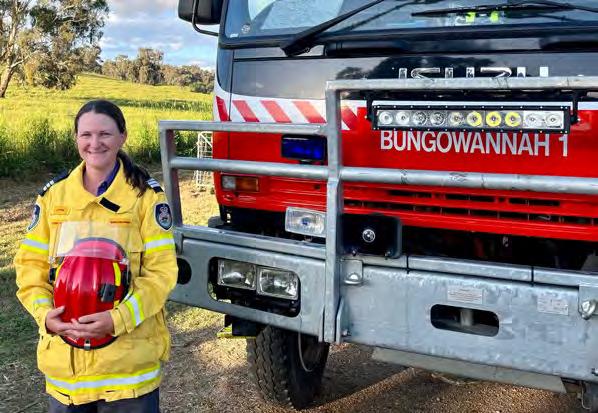
“The Service is about teamwork,” says Theresa.
“It doesn’t matter what your rank is, it doesn’t matter who you are or where you’re from, it’s about whatever it takes to get everyone home and get the job done.”
Since joining the RFS at 17, Theresa has demonstrated clear leadership capabilities and commitment to the Service, and has been a member of the District Senior Leadership Team since 2020.
After four years as Deputy Captain of the Bungowannah Brigade, Theresa was elected Captain in 2022.
“Theresa has naturally stepped forward as a leader in the roles she’s had with the RFS,” said Inspector Andrew Gray from Area Command South Western.
“We’re hoping Theresa is just the first of many young women who will take on operational leadership roles like this in Area Command South West.
“Her appointment will have the benefit of showing other young women a positive pathway.”
The Bungowannah Brigade, which protects properties in a small farming community along the Victorian border west of Albury,
responds predominantly to grass fires and motor vehicle accidents.
Theresa hopes to encourage more members, male and female, young and old, to get involved, progress up the ranks and take responsibility for their properties, as her father and grandfather did before her.
“I’d really like to get younger people to not just join, but to stay within the RFS,” says Theresa.
“A lot of people my age have left the area, but it’s important to have volunteers there who are ready to help when incidents arise.
“Young people will find uses for what they learn in the Service beyond what they can do in a RFS sense,” she says.
“I have found that the knowledge you obtain when you go to events or join strike teams is transferable to so many aspects of your life.
“Additionally, the social aspect of the Service is amazing, in your community but also more broadly within the RFS. A diversity of views and ideas is great because it allows you to bounce off each other.”
When not active in her roles with the RFS, Theresa manages the livestock on her family’s farm and enjoys reading, tennis and skiing.
34 BUSH FIRE bulletin || GENERAL NEWS
Photo by Graham Star
ANY-WEATHER FRIENDS: GOAT PILOTS CONTINUE ACROSS NSW
With NSW having experienced prolonged wet conditions that hampered traditional burning and mechanical hazard reduction activities, our four-legged firefighters will keep munching into the future.
After the success of the Service’s goat pilot program in 2021 in Clandulla, goats are engaged from six companies across the state to work in areas with special hazard reduction needs.
“We are not able to burn certain areas due to environmental factors, so that’s where the goats are terrific,” says Assistant Program Coordinator, Alex Picker.
“For instance, the job at Woodbine (Greater Sydney) would have been unsafe to place people due to trip hazards. There’s also steep terrain and noise pollution considerations, so sites like that are good candidates for work by the goats.
“The herd size is usually 30 to 50 goats –we’ll section off an area with a fence and the goats will chew whatever they want to eat.
“Contrary to popular thought, goats will not eat anything, but they will eat the majority of weeds and grasses.”
The trials have involved a range of different goat breeds, which has given the RFS the opportunity to expand its hazard reduction toolbox.
“Enabling the agency to complete the largest amount of hazard reduction for our communities as possible is the ultimate goal, and anything that allows us to achieve that is positive,” says Inspector Troy Gersback.
“Goat pilots are continuing across NSW –Woodbine has been completed and the goats are now working in the Cranebrook area on a similar job.
“We are working to identify further grazing sites and the pilot has been extended until the end of June 2023 as a result of the success and progress made.”
Whether it be using goats, sheep or cattle, in a controlled and managed fashion, grazing provides an alternative option for hazard reduction for the RFS and landholders alike.
 Photos by Troy Gersback
Photos by Troy Gersback
They graze to fend off the blaze, with stomachs tough enough to digest fuel sources that are poisonous or unpalatable to other herbivores, and no aversion to munching in the rain.
BUSH FIRE bulletin || GENERAL NEWS 35
RFS AT THE WORLD PRIDE AND MARDI GRAS

Sydney Mardi Gras and Sydney World Pride came together on Saturday 25 February to present a global LGBTQIA+ Pride festival, the first in the Southern Hemisphere. The 2023 theme; Gather, Dream, Amplify was developed in partnership with the First Nations and LGBTQIA+ communities.
 Photos by Patrick Elliott-Brennan and Alanna Rados
Photos by Patrick Elliott-Brennan and Alanna Rados
36 BUSH FIRE bulletin || AWARDS AND EVENTS
On the glittering night, more than 60 RFS members including all RFS Executive staff proudly marched with their friends and fellow volunteers.



The RFS truck was decorated with a design inspired by The Beatles’ artwork from the 1960’s and incorporated a quote by John Lennon: ‘A dream you dream together is reality’.

BUSH FIRE bulletin || AWARDS AND EVENTS 37
NEW FIRE TRAIL MAKES A GREAT DIFFERENCE FOR MOUNT HELEN COMMUNITY
BY ROSS HARRISON, SENIOR DEPUTY CAPTAIN OF THE WILLOW TREE BRIGADE
In 2022, the Mount Helen Strategic Trail was identified as a high priority for upgrade by the Liverpool Range Bush Fire Management Committee. The Liverpool Range District, North Western Area Command, the RFS Fire Trails team and Soil Conservation Service collaborated together on the upgrade.
Large telecommunication towers and infrastructure exist on the top of Mount Helen which serve Sydney and northwest NSW, so upgrading the road was vital to maintain a safe road for vehicles.
Additionally, the mountain is susceptible to bush fire due to its height at 1,200 metres – it is ensconced in thick bush amid very steep terrain.
In September 2017, there was a dry lightning strike close to the top of Mount Helen, which started a two-hectare fire that grew to more than 2,000 hectares in four days and came close to requiring a Section 44 declaration.
It was about 10°C at night with no wind and high humidity, yet the fire proved difficult to control, principally because we could not get up the mountain due to the very steep terrain.
Fire behaviour on the mountain is very different to fire in grassland.
I have seen fires progress downhill against the wind due to the way wind moves around the mountain top. Firefighters needed access to the top to avoid this happening in the future.
Another important consideration was that the town of Murrurundi is located close to the base of Mount Helen on its southeastern flank. Established in 1840 and with a population of around 1,000 people, many of the buildings and homes reflect an established country town.
A bush fire on the mountain’s northwestern side driven by a westerly wind has the potential to shower the town with burning embers. This would be devastating for the whole community.
The original road to the top of the mountain runs over four private properties and has not been consistently maintained. Due to the communications equipment at the top, there was a constant stream of technical people using the fire trail, creating wear and tear on the road.

38 BUSH FIRE bulletin || GENERAL NEWS
Eventually the road wore down to the extent that vehicles were having difficulty using it.
The RFS, through extended consultation with affected landowners, proposed to bring the road up to the RFS Fire Trail standard.
After much planning and review, construction began. This was done by NSW Department of Soil Conservation and took about six weeks of work.
The road-building crew used two large graders, two vibrating 16-tonne road rollers, a Posi-Track, several large excavators and a dust (water) suppression truck.
At one stage there were seven large tip trucks (each with a 15-tonne capacity) with trailers running back and forth, bringing up a total of 4,500 tonnes of material.
Passing and turnaround bays were needed so that vehicles could safely transit the road up or down. The road is single lane and narrow in parts, with a very steep drop off on the side. Some sections of the road had to be cut into the hillside for safety.
As one of the affected land owners, a longtime member of the RFS and part of RAFT Tamworth, I watched with great interest the building of the road.

Willow Tree Brigade extended an invitation to attend a review of the fire trail (as it is in our area of responsibility) to all local first responders. We looked at threats to assets, water sources and likely fire behavior, escape routes and discussed the strike team base, helicopter landing space and safety refuges.
We went up the mountain with four group captains, representatives from Soil Conservation and several local brigade vehicles, while I ran a commentary over the radio about the various aspects of the mountain that concern firefighting.
Everyone enjoyed the review, as well as the barbeque lunch on my property, funded by the Coles voucher given to brigades after the 2019/20 fire season.
FIRE TRAIL FACTS
- The fire trail cost approximately $840,000 for the planning, approvals and construction works.
- Design work took approximately six months due to the complex environment and the many stakeholders involved.
- Construction work was completed in approximately three months and certified in April 2023.
Having the discussion and spreading knowledge of different considerations regarding emergencies on the mountain has helped prepare us for any future emergencies.
The upgrade of the fire trail was a much needed project and one which will benefit the whole community for years to come.
SCAN the QR code to watch a video about this and other trails as part of the Strategic Fire Trails Project.
Main photo: Upgraded fire trail at Mt Helen. Right: The Mt Helen fire trail before the upgrade. Breakout: Photo of the fire trail prior to the upgrade. Photos by Jamie Carter and Ross Harrison
BUSH FIRE bulletin || GENERAL NEWS 39
AT THE ROYAL EASTER SHOW
After a long hiatus the RFS returned to the Royal Easter Show in 2023.
The RFS display in the Home and Lifestyle Pavilion was popular during the sunshine, and even more popular when the rain came down, which was prodigious during the ten days of the Show.
A Cat 9 Striker, a new model fresh off the production line, was the feature of the stand along with information on the new Fire Danger Ratings. The truck proved to be a hit for young people and children who could jump in the driver’s seat, have their photos taken and receive a red RFS helmet.
More than 60 staff and volunteers crewed the stand from 8am to 8pm each day of the Show. We estimate that the RFS had interactions with around 55,000 showgoers.

The Royal Easter Show is an excellent opportunity to meet with people from all walks of life, have a laugh and remind people of the role of the RFS across NSW.
It wasn’t uncommon for ‘off-duty’ RFS members to pop in for a chat, check out the truck’s capability and receive a compostable fire helmet for themselves or their children.
“It’s great to be back,” was the overall sentiment from the members crewing the stand. Members of the public were appreciative too and many echoed one woman’s comment: “Thank you for all that you do!”
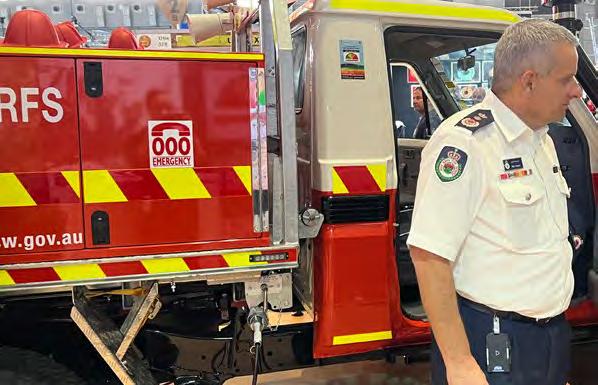
40 BUSH FIRE bulletin || AWARDS AND EVENTS
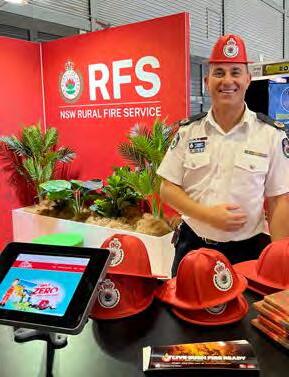
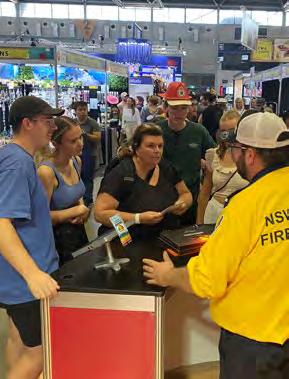
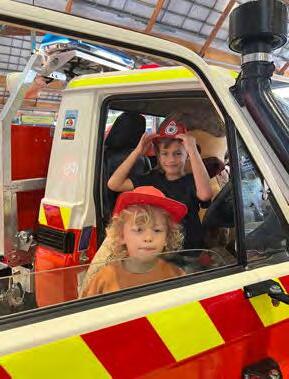
 Clockwise from above: Commissioner Rob Rogers AFSM, and member Tracey Anderson at the RFS stand at the Royal Easter Show. Assistant Commissioner Ben Millington tries on a new helmet.
Clockwise from above: Commissioner Rob Rogers AFSM, and member Tracey Anderson at the RFS stand at the Royal Easter Show. Assistant Commissioner Ben Millington tries on a new helmet.
BUSH FIRE bulletin || AWARDS AND EVENTS 41
Kids try on their helmets in the Cat 9 show vehicle. The Royal Easter Show crowds flock to the RFS stand Information Desk. Members Darryl Foster, and Tom Easton. Photos by Victoria Quested.
Bravery and Service Awards 2023
The fourth of May is the Feast Day of St Florian, Patron Saint of Firefighters, and International Firefighters’ Day. On this day each year, the RFS holds an internal awards ceremony to recognise the bravery and outstanding service of members.
Commissioner’s Award for Valour
• Deputy Group Captain Philip Blackmore, Central Coast
Deputy Group Captain Blackmore was nearby when a car explosion, caused by an acetylene cylinder, rocked the township of Gwandalan on Father’s Day 2020.
Assisted by an off-duty paramedic, Mr Matthew Wilson, Deputy Group Captain Blackmore rushed to assist and began resuscitation on a man found lying beside the vehicle with significant burns and injuries.
“The pair worked in extremely volatile and dangerous conditions to give the man every chance of survival, providing CPR while the car was still burning nearby,” said Commissioner Rogers. “Deputy Group Captain Blackmore put himself in harm’s way to try and save someone’s life.”
Recognised Efforts
Commissioner Rogers also recognised the efforts of RFS Aviation Rescue crews, who since February 2022 have performed more than 180 rescues to save people trapped by rising floodwaters.
“On 14 November, Aviation Rescue Crew members confronted complex and challenging conditions to undertake 67 rescues by helicopter in the township of Eugowra,” said Commissioner Rogers. “This is the largest number of successive rescues performed by rescue aircraft on any single day in Australian history.”
Commendation for Bravery
• Firefighter John Agustin, Canobolas
• G roup Captain Andrew Macdonald, Macarthur
• Firefighter Michael Miles, Canobolas
• Firefighter Josh Newbigging, Mid Lachlan Valley
• G roup Captain Ross Newbigging, Mid Lachlan Valley
• Firefighter Thomas Newbigging, Mid Lachlan Valley
• C aptain Alan Noble, Canobolas
• Firefighter Lachlan Noble, Canobolas
• Senior Deputy Captain Dallas Pearce, Canobolas
• G roup Captain Craig Robertson AFSM, Illawarra/Sutherland
• Firefighter Blake Shumack, Macarthur
• C aptain Bill Turner, Canobolas
• Firefighter Patrick Welsh, Mid Lachlan Valley
This year, Commissioner Rob Rogers AFSM was joined by Minister for Emergency Services, the Hon Jihad Dib MP at the RFS State Training Academy in Dubbo to honour nearly 80 volunteers, salaried members and teams for their bravery and service.
Unit Citation for Bravery
• Kundle/Moto Rural Fire Brigade, Mid Coast
Commendation for Service
• Firefighter Daniel Andrews, Mid Murray
• Deputy Group Captain Andrew Barnard, Mid Lachlan Valley
• C aptain Neville Battistuzzi, Northern Rivers
• G roup Captain Dale Bowles, Mid Murray
• C aptain Alesha Buckley, Mid Murray
• Deputy Group Officer Joseph Campbell, Mid Lachlan Valley
• Firefighter Mavis Goodlad, Northern Rivers
• G roup Officer Robert Graham, Northern Rivers
• Firefighter Rosanna Joshua, Southern Tablelands
• G roup Officer David Lang, Mid Murray
• Dr Stuart Matthews, RFS HQ
• C aptain Barry Morgan, Northern Rivers
• Inspector Michael Robinson, Mid Lachlan Valley
• G roup Captain James Smith, The Hills
• Deputy State Protocol Officer Lesley Smith, Cumberland
• O fficer L2 Bradley Stewart, Riverina
• Firefighter Cheryl Whitney, Northern Rivers
• C aptain Jeffrey Whitney, Northern Rivers
• Deputy Captain Jeff Wood, Macarthur
Unit Citation for Service
• Australian Fire Danger Rating Project (AFDRS) National Project Group, RFS HQ
• Australian Fire Danger Rating Project (AFDRS) NSW Implementation Team, RFS HQ
• Aviation Rescue Crew, State Operations / Operational Field Support, RFS HQ
• Gwandalan Rural Fire Brigade, Central Coast
• L ake Munmorah Rural Fire Brigade, Central Coast
• Mt Arthur Rural Fire Brigade, Orana
• Oakville Rural Fire Brigade, Hawkesbury
• O rmond-Mungery, Waratah, Tullamore, The Troffs and Sandy Creek Rural Fire Brigades, Mid Lachlan Valley
• Woombah Rural Fire Brigade, Clarence Valley
• Yeoval and Washpen Rural Fire Brigades, Canobolas
42 BUSH FIRE bulletin || AWARDS AND EVENTS
Certificate of Commendation (Individual)
• Firefighter Jake Bullen-Zorin, Mid Lachlan Valley
• G roup Captain Scott Campbell, Clarence Valley
• Andrew Peter (Peter) Collins, Capability, South Western
• C aptain Kathleen Everett, Hunter Valley
• Deputy Group Officer Andrew Grabham, Chifley/Lithgow
• G roup Officer Christine Hartley, Northern Rivers
• Senior Deputy Captain John Holmes, Northern Rivers
• G roup Officer Garry Johnston, Northern Rivers
• Firefighter Campbell Kenyon, Far North Coast
• C aptain Todd McCallum, Mid Murray
• Firefighter Neil Wheeler, Far North Coast
• Senior Deputy Captain Tanya Willey, Chifley/Lithgow
Certificate of Commendation (Unit)

• B errigan Rural Fire Brigade, Southern Border
• B ourke HQ Rural Fire Brigade, Far West
• B roke Rural Fire Brigade, Hunter Valley
• B ulli Rural Fire Brigade, Illawarra/Sutherland
• B uxton Rural Fire Brigade, Southern Highlands
• Community Risk Team, Area Operations, Area South Eastern
• Cudgen Rural Fire Brigade, Far North Coast
• Cumberland Operational Support Rural Fire Brigade, Cumberland
• G ledswood Rural Fire Brigade, Macarthur

• G unning - Fish River Rural Fire Brigade, Southern Tablelands
• H awkesbury District, Hawkesbury
• M acarthur COVID-19 Assistance Team, Macarthur
• Mid Lachlan Valley Team, Mid Lachlan Valley
• Mid Murray Support Brigade, Mid Murray
• M oulamein Rural Fire Brigade, Mid Murray
• Mt McDonald and Wyangala Rural Fire Brigades, Canobolas
• N orthern Rivers District, Northern Rivers
• Spring Creek Road Flood Assistance, Cudgegong
• St John Ambulance SA, NSW Flood Deployment, Mid Murray
• State Training Academy Team, Preparedness and Capability
• Strike Team East 19/042, Cumberland and Blue Mountains
• Wardell and Meerschaum Vale Rural Fire Brigades, Far North Coast
• Wisemans Ferry Rural Fire Brigade, The Hills
BUSH FIRE bulletin || AWARDS AND EVENTS 43
Above: Commissioner Rob Rogers with Deputy Group Captain Philip Blackmore, recipient of the Commissioner’s Award for Valour, and members of the Gwandalan and Lake Munmorah Fire Brigades with their Commissioner’s Unit Citation for Service awards. Photo by Adam Hollingworth.
AUSTRALIAN FIRE
The Australian Fire Service Medal (AFSM) is awarded to a member of an Australian fire service for distinguished service. Congratulations to the eight RFS members who received an AFSM as part of the 2023 Australia Day Honours, recognising their commitment to the community.

GROUP CAPTAIN BRUCE ANGEL Riverina
Group Officer Bruce Angel joined the Tarcutta Brigade in 1968 and was elected Deputy Captain in 2001, Captain in 2003 and Group Captain in 2012. A skilled firefighter, Strike Team Leader, Incident Controller and Incident Management Team (IMT) member, Bruce has often been a first responder to many motor vehicle accidents and incidents on the Hume Highway.
Bruce has demonstrated great leadership to his own Brigade and others in the Riverina Group 8, incorporating the brigades of Humula, Oberne Creek, Tarcutta and Umbango-Oberne. He has represented his peers on the Senior Management Team, Service Level Agreement Committee and at Group Officer and Captains’ meetings.
He has attended numerous incidents during his 54 years of service and his wealth of local knowledge has been invaluable in protecting Tarcutta and the surrounding communities. His leadership as the Incident Controller when the Dunns Road fire started in January 2020
and his subsequent efforts as Divisional Commander are to be commended. The knowledge he provided on the ground and relayed to the IMT was instrumental in determining incident action plans.
DEPUTY GROUP CAPTAIN JENNIFER BAMMAN
Far South Coast
Deputy Group Captain

Jennifer Bamman joined the Surf Beach Brigade after a major fire impacted the area in January 1994. Consistently demonstrating exceptional leadership and achievement, she was awarded the Commissioner’s Commendation for Service in 2001 for her commitment to District training and development. She was awarded Life Membership in 2010. She has held various roles, including Deputy Captain, Senior Deputy and Brigade Captain and in 2013 became one of the first female Group Officers elected in the region.
She remains in that position, as well as fulfilling the roles of Permit Officer and IMT Officer and serving as a member of the Far South Coast Training and Senior Management Teams.
With multiple qualifications across all facets of operational activities, Jennifer has contributed to the team as an Instructor, Course Coordinator and Assessor.
One of the first female Compressed Air Breathing Apparatus (CABA) operators on the Far South Coast, she has been heavily involved in the provision of CABA and the Advanced Structural Firefighting training.
Instrumental in the development of junior brigade members, guiding volunteers and with extensive Incident Management experience, she has led multiple strike teams across the state. During the 2019/20 bush fire season, she served as Divisional Commander for the devastating Currowan and Clyde Mountain fires for numerous days while her own family and friends were under threat.
GROUP CAPTAIN PETER BULLIMAN
South West Slopes
Group Captain Peter BuIliman joined the Boara Brigade in 1982 and has held the positions of Deputy Captain, Senior Deputy Captain, Captain, Brigade Training Officer and Brigade President.
44 BUSH FIRE bulletin || AWARDS AND EVENTS
SERVICE MEDALS 2023

Peter has represented volunteers within the Senior Management Team and RFSA Consultative Committee, encouraging growth in the organisation at all levels. His leadership has transformed Boara Brigade, now known for impressive incident response and support with diverse membership. He was a driving force in developing the capability of the South West Slopes Zone, which now has volunteers capable of Remote Area Firefighting and two brigades with Breathing Apparatus capability. Peter is a firm believer in sharing knowledge at all levels and as an instructor for most training courses across the Zone, he has maintained a level of course consistency and understanding of new advances and techniques.
While responding to fires and other emergencies, Peter has been an integral part of the Zone Duty roster of personnel responsible for coordinating the response to emergencies, while developing his capability to act as a Duty Officer.
GROUP CAPTAIN WARREN CREE
Northern Beaches
Group Captain Warren Cree has a longstanding personal and family commitment to the RFS, with his father, mother, brother, wife and children all involved as volunteers and salaried officers.
Following his father into the Davidson Brigade at age 16 in 1986, by 18, Warren was an active, experienced member and elected Deputy Captain. He served in that capacity for 12 years, attending many fires and incidents, leading training and engaging the community.
He was elected as Senior Deputy Captain in 2000 and as Captain in 2002. Re-elected to that position for five terms until 2007, he was elected as a Deputy Group Captain and then Group Captain in 2020.
Warren has managed many local fires as Incident Controller, Operations Officer and Logistics Leader and most recently on multiple deployments during the 2019/20 bush fire season. He was also selected as a Strike Team Leader on interstate deployment to Western Australia.
Contributing countless hours to District brigade meetings, Cadets and District training initiatives, working as an advanced structure firefighting and breathing apparatus principal trainer, Warren helped many individuals through the 2019/20 fires.
He is a dedicated member of the Northern Beaches District Advisory Committee, Senior Management Team, Bush Fire Management Committee and the Area Command Engagement Group.
DEPUTY COMMISSIONER PETER MCKECHNIE
Central Coast
Deputy Commissioner Peter McKechnie joined Narara Brigade as a volunteer firefighter in 1994, moving through the ranks to become Deputy Captain and Captain, then Deputy Group Captain for the Gosford District.
Peter has mentored and trained many members and led firefighting responses across the Central Coast and further afield. Becoming a salaried officer in 2002, instrumental in strategic management, leadership and operations, Peter’s roles have included Director Area Operations, Manager State Operations and Deputy Commissioner of Field Operations, a role he has held since 2021.
Deployed to major fires and emergencies (interstate and overseas) as an Incident Controller, Major Incident Coordinator and State Operations Controller, Peter has lead Australian deployments to the US and Canada, as well as representing the RFS in Singapore and Indonesia.
Throughout the 2019/20 fire season, Peter regularly filled the role of State Operations Controller, responsible for coordinating firefighting operations, resources and emergency warnings across the state.
BUSH FIRE bulletin || AWARDS AND EVENTS 45
He oversaw the response to an unprecedented 17 bush fires at an Emergency Warning level on 8 November 2019, and also deployed to firegrounds to support firefighters and IMTs.
He has also been responsible for overseeing the development of the RFS centralised dispatch system, modernising the way in which brigades respond to emergencies.
GROUP CAPTAIN MAURICE MCMILLEN Chifley/Lithgow
Group Captain Maurice McMillen joined the Eglinton Brigade in 1974. His commitment to the Brigade has seen him hold all field positions and the role of President, as well as contributing to the after-hours emergency call out system, dispatching fire and emergency service vehicles on weekends and late into the evening and raising funds for the Brigade. He was awarded Eglinton Brigade’s first life membership in July 2022.
Maurice has led strike teams to fires and storm emergencies in Sydney, Coonabarabran, Pilliga, Blue Mountains and Bombala. During the 2019/20 bush fire season, he was an IMT Operations Officer and led strike teams to the Gospers Mountain fire.
In 2013, during the State Mine fire, with all staff committed to the IMT, he and his wife Barbara kept the Chifley Fire Control Centre office open supporting local volunteers, organising day/night shift strike teams and issuing equipment.
He received the Commissioner’s Certificate of Commendation in 2016 in recognition.
For 20 years, he has trained and mentored many members participating in the Zone Biannual Exercise. Chairperson for Chifley Zone RFSA for three terms, an alternate delegate for the RFSA State Council and member of the Chifley Senior Leadership Team and Zone Liaison Committee, Maurice currently sits on the RFS/RFSA joint consultative committee.
CAPTAIN KYM STANFORD Namoi/Gwydir
Captain Kym Stanford’s leadership potential was recognised not long after she joined the Mungindi Brigade in 1995. Kym was elected Senior Deputy Captain in 1999 and elected Captain two years later. The fact that she has remained in that role for more than 20 years is testament to the high regard in which she is held by her Brigade.
In 2022, Kym shared a Commissioner’s Unit Citation for Service awarded to the Mungindi Brigade for its response to a large fire in the main street of Mungindi in 2020 that destroyed the town’s supermarket. She was instrumental in leading the response and coordinating other emergency services from both NSW and Queensland, along with the community and business members who assisted.
In addition to her admirable longterm operational commitment, she has held the position of Brigade President since 2013, is a Permit Officer, and as a Trainer and Assessor, has supported the establishment of new operational capabilities. She has led her Brigade to meet the changing needs of the RFS and community, including qualifying as a Rescue Operator when the
need arose to provide rescue capabilities for Mungindi and the surrounding area.
GROUP CAPTAIN CRAIG WALTERS Orana
Group Captain Craig Walters joined the Elong Elong Brigade in 1987 and then Wongarbon Brigade as a dual member in 2015. He has held many positions including Secretary, Permit Officer and Training Officer, Deputy Captain, Senior Deputy Captain, Captain and was also elected as the Chair of the Orana Team’s Senior Management Committee. A proactive operational member, he has been deployed to major incidents locally, across NSW and interstate to Tasmania, as a Brigade Captain, Strike Team Coordinator and Sector and Divisional Commander. Whenever available, he will assist in IMTs. He is committed to training, regularly serves as a course instructor and is a strong supporter of the area’s interbrigade Black Snake Competition. He has been an advocate for rural industries, landholders and communities, delivering seminars for new staff members undertaking the RFS Operational Officer Training program for volunteers living in Western NSW and combating grassland fires.
With a farmer’s perspective and experience as a Divisional Commander, he has also been involved in the development of the Farm Fire Unit project and was instrumental in delivering the Secondary School Cadet Program in the Dubbo area as well as the Neighbourhood Safer Place program.
46 BUSH FIRE bulletin || AWARDS AND EVENTS
MEMORIAL GARDEN DEDICATED TO FALLEN FIREFIGHTERS UNVEILED IN DUBBO
A memorial garden in the grounds of the RFS training academy in Dubbo was unveiled on 5 August 2022, dedicated to RFS members and contractors killed in the line of duty.

Then Minister for Emergency Services and Resilience and Minister for Flood Recovery Steph Cooke MP, Member for Dubbo Dugald Saunders MP and RFS Commissioner Rob Rogers addressed the families of the fallen.
Ms Cooke said it was important to commemorate the fallen RFS members and contractors, who bravely stepped up in some of the state’s darkest days.
“While we do everything we can to ensure the safety of our emergency service members, tragically, sometimes these men and women do not make it home. We will always remember them,” said Ms Cooke.
RFS Commissioner Rob Rogers said the memorial stands as a tribute to the 95 RFS members and aviation contractors who lost their lives in the line of duty or from fire-related illnesses since 1932.
“We honour these ordinary members of the community who come forward and do extraordinary things. In remembering them, all will be welcome here to simply sit, contemplate and remember.”
The garden is comprised of two semi-circular walls flanking a bronze statue of a RFS firefighter leaning on a rakehoe, which was one of the iconic images from the devastating 2019/20 Black Summer bush fire season.
A bronze propeller also recognises the lives of the crew of Bomber 134, a C-130 Hercules firefighting plane that crashed near Cooma on 23 January 2020, tragically killing the three US airmen on board. Work commenced to design and build the memorial garden at the RFS State Training Academy at Dubbo in 2021, and the RFS wishes to thank the Rural Fire Service Association (RFSA) for their significant financial commitment towards the memorial garden.
“To be here today is humbling,” said RFSA President Scott Campbell. “This project started as a conversation between RFSA Vice President Steve Robertson and Deputy Commissioner Peter McKechnie, and from that conversation we have what we see here today.
“What an amazing way to reflect, recognise, learn and pay respect to those RFS members and contractors who didn’t get to go home at the end of their shift. The RFSA is proud to partner with the RFS in the creation of this memorial garden.”
All who will find solace in this memorial garden are welcomed to visit it at any time and observe the names of 95 men and women recorded beside the garden.
Photo by Sylvie Woods
BUSH FIRE bulletin || GENERAL NEWS 47
MICK HOLLAND 1968 –
2022
Superintendent Michael (Mick) Holland, a celebrated member of the RFS and District Manager of Chifley/ Lithgow, sadly passed away on the 19 December 2022.
Mick joined the RFS as a volunteer in 1984 at the age of 16. He was inspired to join the RFS by his father, Ernie Holland, who co-founded the Jenolan Caves Brigade back in 1979. Throughout his life Mick was an active member of a number of brigades, including Jenolan Caves, Oberon Headquarters, Edith, Black Springs and Norway. His leadership skills were recognised and Mick was elected Captain of Oberon Headquarters Brigade in 2000 and served for five years before becoming Deputy Group Captain for the Chifley/ Lithgow District.
Mick had always been inspired to help train more volunteers and in 2008 he was encouraged to apply for the Learning and Development Officer for the Chifley/Lithgow District, which gave him a chance to help volunteers every day.
In 2017 Mick was awarded a National Medal 1st Clasp for his extraordinary commitment to the RFS and the local community.
Commissioner Shane Fitzsimmons said at the time, “Michael is dedicated to ensuring RFS volunteers receive world class training and his valuable insight is often sought from across NSW, in addition to his experience as an authorised Wildfire Investigator and serving in various roles with multiple Incident Management Teams.”
Mick was appointed Acting District Manager of Chifley/Lithgow in 2018, swiftly providing direction and stability to support volunteers and staff. His leadership was critical in preparation during the horrific 2019/20 Black Summer bush fires. He was confirmed as Chifley/Lithgow District Manager and appointed as Superintendent in 2021.
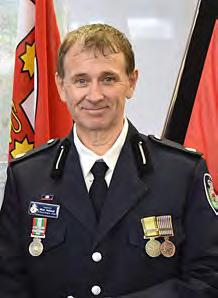
Before sadly losing his battle with cancer, Mick fought with determination and spirit for two years. His last wish to those who wanted to pay their respects was to donate something to the Royal Flying Doctor Service or Daffodil Cottage Bathurst. Each of these organisations were instrumental in supporting Mick and his family in the last few years of his life.
Michael Holland will be remembered as a dedicated volunteer who was an outstanding leader of the Chifley/Lithgow District.
48 BUSH FIRE bulletin || VALE VALE
DAVID ‘DOUBLES’ DOBLINGER 1961 –
2022
A valued member of the RFS and holding a number of senior roles, David ‘Doubles’ Doblinger had been a member of the Lake George District for nearly 40 years, recently moving to Tuross from Queanbeyan for a sea-change with his partner Wendy. Sadly, on 9 December David tragically passed away after suffering a heart attack, aged 61.
Beginning his service to the community in 1977, David joined the Queanbeyan City Bush Fire Brigade and the Queanbeyan Unit of the State Emergency Service at the age of 16. In a volunteer capacity with RFS, he held the roles of Deputy Group Captain, Captain, Senior Deputy Captain and Deputy Captain. He was a member of several brigades including Wamboin, Ridgeway, Queanbeyan City, Lake George Support, Jerrabomberra Creek and Tuross Head.
In January 2022 David became an employee with the South Eastern Area Command before being promoted to the role of Operational Officer level 3, Regulatory Coordinator in November. David was in the middle of his Operational Officer Level 3 Induction in December 2022 when he suddenly passed away on a weekend at home. His manager and friend, Chief Superintendent Paul Simakoff-Ellims, Area Commander South Eastern, remembers him as “the sort of bloke you wanted on your side, whether as your mate relaxing after work or on an active fireground where lives were at risk.”
“He was irreplaceable, someone you could always trust and who was always there for you.
“‘Doubles’ seemed to know when someone was in trouble, without that person saying a word. Few people in the RFS family didn’t know or hadn’t heard of the veteran firefighter. But, as much as he was a people person, he was also a devoted family man to partner Wendy and his children.”
A passionate and prolific trainer and assessor, David held many qualifications and loved to inspire members across the state to be their best. His enduring legacy will be as a learner, leader, mentor and a friend to many within the RFS, emergency services and the community. His dedication to the path he followed was unwavering, determined and reflected standards we should all try to live up to.
“He was a truly special individual,” said Paul. “Our sincerest condolences go out to Wendy and their families.”
Parts of this story are from https://aboutregional.com.au/rfs-mournsdeath-of-veteran-firefighter-doubles/

BUSH FIRE bulletin || VALE 49
Photo by Nathan Heerey from Queanbeyan City RFB.
VALE
What was your first job at the RFS and tell us the highlights of your career?
I started at the RFS during the 2002 fires, as a volunteer at the Kenthurst Brigade in the Hills District, then became a staff member after the Canberra fires in 2003.
Starting as an intern in the Media team, I worked my way up to Media Manager, where I rolled out the first RFS recruitment campaign called ‘The Good Fight’.
After the Black Saturday bush fires in Victoria in 2009, I was offered a secondment to the Victorian Office of the Emergency Services Commissioner.
During that time, I assisted the Federal Bushfire Warnings Task Force in updating the Fire Danger Ratings scale that led to the establishment of the bush fire warning system of Advice, Watch and Act and Emergency Warning.
When I returned to the RFS, I was Director of the Operational and Mitigation Services team, where we rolled out the Rapid Aerial Response Team capability with volunteers, and built up our Heavy Plant and base camp capability.
At that time, I also led the enhancement of State Mitigation Support Services (SMSS) to assist volunteer brigades with preparation works for hazard reduction burns and provide logistics and operational support during major incidents.
In 2013, I was awarded a Commissioner’s Commendation for Service and in 2015, I was appointed the first female RFS Assistant Commissioner and went on to work as Director of Regional Services.
ASSISTANT COMMISSIONER REBEL TALBERT
After more than 20 years in the RFS, Assistant Commissioner Rebel Talbert has moved on to head up the Fire and Natural Hazards Group at NSW Forestry. Rebel delivered significant projects during her career, and was the first woman to have held the rank of Assistant Commissioner at the RFS.
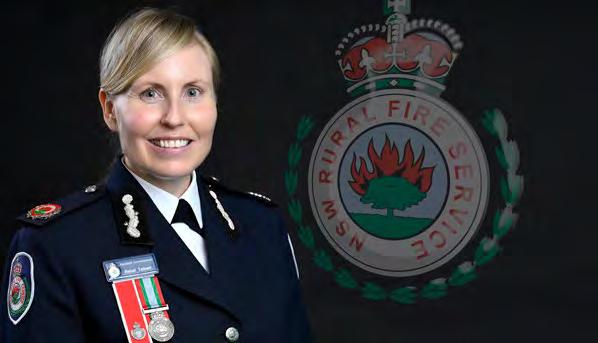
I remain immensely proud of the work we achieved during those years.
A good example is during the 2019/20 Black Summer fires, when I filled a number of operational roles including as State Operations Controller. A highlight was working closely with a small team to develop ‘red maps’. From an idea to publishing them in about 10 hours, they set a new standard for explaining serious fire and weather risks to the community.
Tell us a bit about your new role at NSW Forestry?
In my new role I have been assisting with implementing NSW Forestry’s Bushfire Inquiry and Royal Commission recommendations as well as collaborating on some key projects.
This new opportunity at Forestry is leading the Fire and Natural Hazards Group, primarily focused on preventing bush fires. Forestry Corporation owns 2 million hectares of forest across the state. Within that there’s 250,000 hectares which are vital to Australia’s timber supply, so that’s a high risk asset which needs to be protected.
What have you most enjoyed about working for the RFS?
I’ve enjoyed a career which has been varied, from working in media and communications, to ending up at the cutting edge of fire science. I have loved being able to turn my passion of firefighting as a volunteer into a career.
I’ve enjoyed being in a position where I can help volunteers realise their ideas, represent them and champion their passions, while making such great friendships.
CELEBRATING 20
OF SERVICE
YEARS
FROM
50 BUSH FIRE bulletin || GENERAL NEWS
114 YEARS OF SERVING THE COMMUNITY
On 27 August 2022, the Murrumbateman Brigade celebrated 114 years of service to their community in a reception at a local vineyard.
Until recently, the 65-strong member Brigade had hoped that 2020 would mark the Brigade’s centenary. Unfortunately, the plans to mark the milestone in 2020 were cancelled due to COVID-19 restrictions. However, in the period of waiting until they could safely come together to celebrate, records were uncovered that revealed a new story.

“We were founded in 1907 by Walter Merriman (later Sir Walter Merriman). This was discovered after extensive research by Community Engagement Officer, Broni Jekyll,” said Brigade Captain, Richard Alley.
“Our own Brigade records were unfortunately destroyed during the 1980s, so it’s great to have made this discovery that we’re even older than we’d originally thought. We thought 2020 was our centenary because our Captains Honour Roll started from 1920 with Sir Walter Merriman.”
Born in Yass NSW, Sir Walter Merriman was a renowned breeder of fine-woolled sheep and very prominent in local affairs. In addition to founding the Murrumbateman Brigade with just a horse-drawn cart to carry water, he held various positions in the community and was knighted at Government House, Canberra in 1956 for his service to the wool industry.
The original horse-drawn cart used by Merriman has remained in the Brigade’s possession and was in fact displayed outside the vineyard on the night of the reception.
“The way they used to fill the cart was using a rake with a billy on the end, they’d scoop out the water one billy at a time,” says Richard. “When members complain about the hand-priming system that we currently have, I remind them of that!”
Recently, the Murrumbateman Brigade assisted the NSW SES in the aftermath of flooding in the Yass Valley, aiding with rescue operations, property assessments and assisting the council to put together a recovery plan. The Brigade is also busy with community engagement in light of Murrumbateman’s considerable population increase over the last few years, as new members of the community seek assistance to protect themselves and their properties.
Brigade members were presented with 15 national emergency medals, two national medals, and 14 long service medals on the night by Deputy Commissioner Kyle Stewart.
“The whole night was thoroughly enjoyed by everyone, it was great to come together, not in yellows, all dressed up to relax and catch up. We’ve never done anything like this before, so it was a fantastic night for all the members to get well-deserved recognition.”
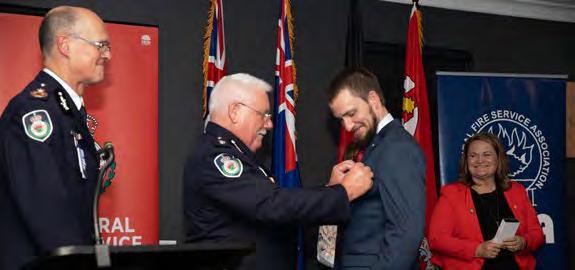 Top: Deputy Commissioner Kyle Stewart, Peter Alley, Richard Alley and Wendy Tuckerman. Right: Richard Alley and Mike Bowers (MC).
Photos by Red Fox Photography
BRIGADE IN PROFILE: MURRUMBATEMAN
Top: Deputy Commissioner Kyle Stewart, Peter Alley, Richard Alley and Wendy Tuckerman. Right: Richard Alley and Mike Bowers (MC).
Photos by Red Fox Photography
BRIGADE IN PROFILE: MURRUMBATEMAN
BUSH FIRE bulletin || BRIGADE IN PROFILE 51
OUR BUSH FIRE bulletin

HISTORY
Volume 8, No. 1 (Autumn, 1970) 52 BUSH FIRE bulletin || OUR BULLETIN HISTORY
BUSH FIRE bulletin on
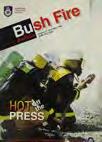
The RFS has joined forces with the National Library of Australia to digitise the entire collection of the Bush Fire Bulletin dating back to September 1952.
All editions of the Bush Fire Bulletin are available online and are fully searchable, making this huge historic archive easily accessible. This collection brings to life the important work our members have undertaken over the years and makes the history of the RFS available for all of Australia and the world to see.

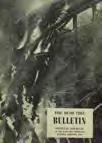

You can search place names, brigade names, dates and fire-related topics such as “fire trails” or “large air tanker”.

HOW TO SEARCH BUSH FIRE BULLETIN ON TROVE

On the Library page of the RFS website, you will find links to browse the various collections of the Bush Fire Bulletin.

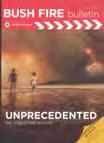


You can also search for articles on a particular topic (such as the town of Merriwa) by using the link provided and following the instructions.

BUSH FIRE bulletin
your details to Bush.Fire.Bulletin@rfs.nsw.gov.au to receive the BUSH FIRE BULLETIN direct to your home or update your emails.
Postcode: Phone: Email address: Update New Subscription eBulletin (email required) RFS Member Or cut out and mail to: Bush Fire Bulletin NSW RURAL FIRE SERVICE
Locked
Granville
stamp
THE JOURNAL OF THE NSW RURAL FIRE SERVICE BULLETIN 06 14 25 32 44 IN THIS ISSUE BRIGADES HELP TSUNAMI VICTIMS HANDLING FOOD SAFELY A CLOSER LOOK AT LOWER HUNTER 12 NEW COMMUNITY EDUCATION UNITS RAIN, HAIL AND FIRE AT GLENHAVEN
Email
Name: (Please include any post-nominals) Address:
Reply Paid 67059
Bag 17
NSW 2142 (No
required)
BUSH FIRE bulletin
ISSN: 1033-7598
Publisher NSW Rural Fire Service I Produced by Media and Communications Editors: Lyndal Sayer and Sylvie Louise Woods. Layout: Nick Lockwood Printed on Monza Gloss; FSC (CoC), ISO 14001, IPPC, ECF environmental accreditation.
Cover photo: Chinook water drop at the Section 44 Wearnes Road Fire. Taken 19/01/23.
Postal address NSW Rural Fire Service Locked Bag 17 GRANVILLE NSW 2142
Social Media www.facebook.com/nswrfs/ @NSWRFS @NSWRFS
Street address NSW Rural Fire Service 4 Murray Rose Ave Sydney Olympic Park NSW 2127
T (02) 8741 5555
F (02) 8741 5550
W rfs.nsw.gov.au
E Bush.Fire.Bulletin@rfs.nsw.gov.au
PP100003459
Photo by: Coffs Coast Strike Team Leader, Captain Tim Jefferies
































 LACHLAN RIVER FLOODING
LACHLAN RIVER FLOODING






 Photo background: Green Valley Talmalmo fire 2020.
Photo by Seth Wilmot. Phone image courtesy of Fire Front Solutions
Photo background: Green Valley Talmalmo fire 2020.
Photo by Seth Wilmot. Phone image courtesy of Fire Front Solutions

 In November 2022, a severe flash flood impacted the small town of Eugowra in the Central West, destroying many homes, businesses and the local RFS station.
In November 2022, a severe flash flood impacted the small town of Eugowra in the Central West, destroying many homes, businesses and the local RFS station.






















 Photos by Troy Gersback
Photos by Troy Gersback

 Photos by Patrick Elliott-Brennan and Alanna Rados
Photos by Patrick Elliott-Brennan and Alanna Rados











 Clockwise from above: Commissioner Rob Rogers AFSM, and member Tracey Anderson at the RFS stand at the Royal Easter Show. Assistant Commissioner Ben Millington tries on a new helmet.
Clockwise from above: Commissioner Rob Rogers AFSM, and member Tracey Anderson at the RFS stand at the Royal Easter Show. Assistant Commissioner Ben Millington tries on a new helmet.










 Top: Deputy Commissioner Kyle Stewart, Peter Alley, Richard Alley and Wendy Tuckerman. Right: Richard Alley and Mike Bowers (MC).
Photos by Red Fox Photography
BRIGADE IN PROFILE: MURRUMBATEMAN
Top: Deputy Commissioner Kyle Stewart, Peter Alley, Richard Alley and Wendy Tuckerman. Right: Richard Alley and Mike Bowers (MC).
Photos by Red Fox Photography
BRIGADE IN PROFILE: MURRUMBATEMAN











